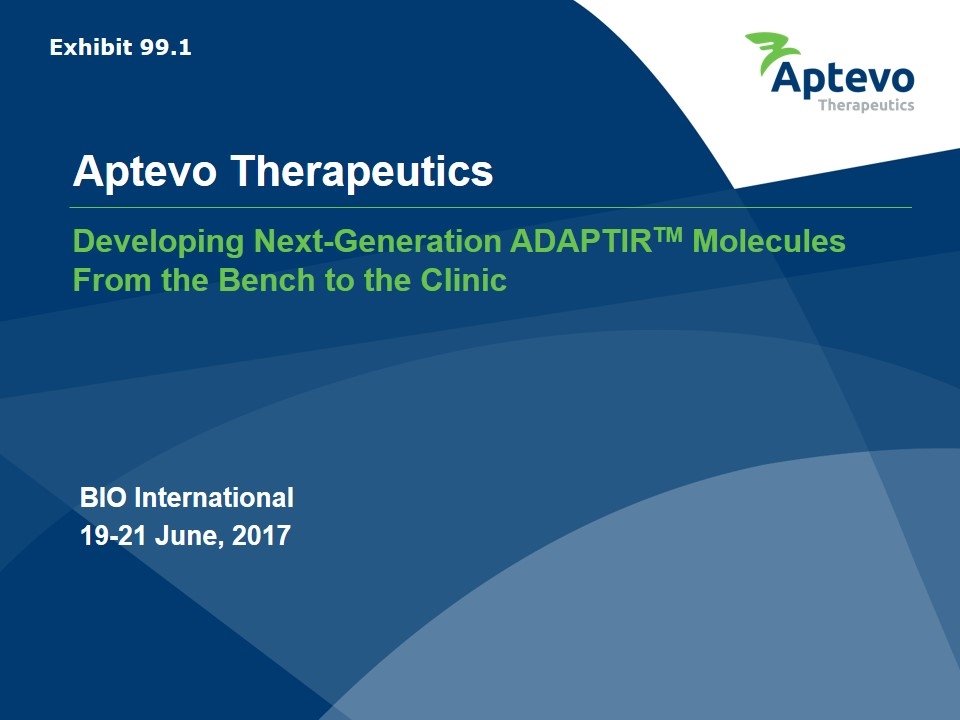
Developing Next-Generation ADAPTIRTM Molecules From the Bench to the Clinic BIO International 19-21 June, 2017 Aptevo Therapeutics Exhibit 99.1
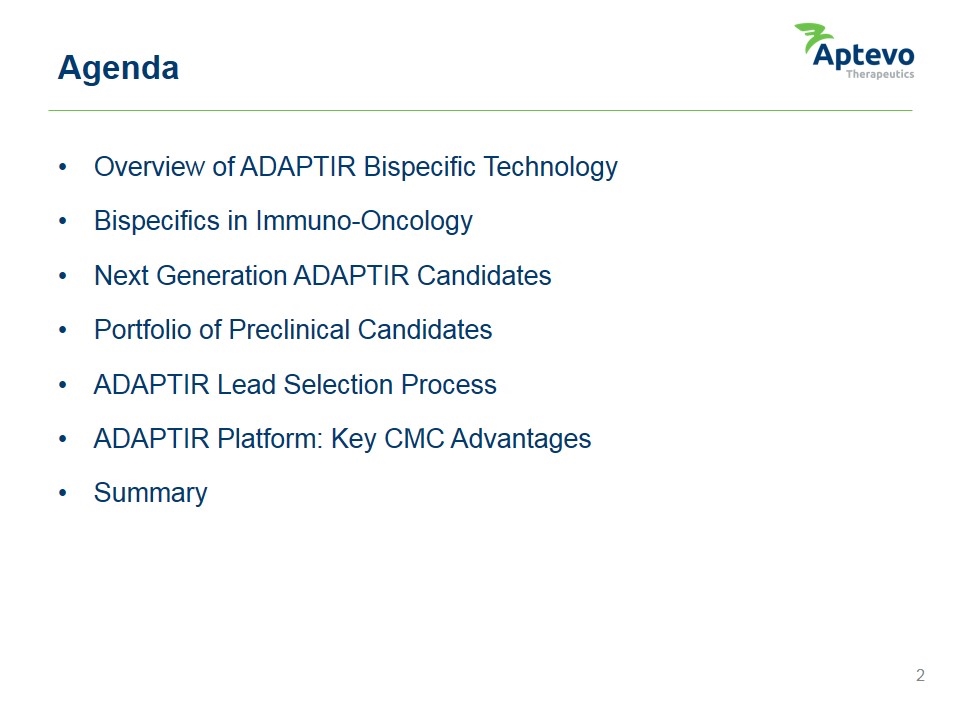
Overview of ADAPTIR Bispecific Technology Bispecifics in Immuno-Oncology Next Generation ADAPTIR Candidates Portfolio of Preclinical Candidates ADAPTIR Lead Selection Process ADAPTIR Platform: Key CMC Advantages Summary Agenda
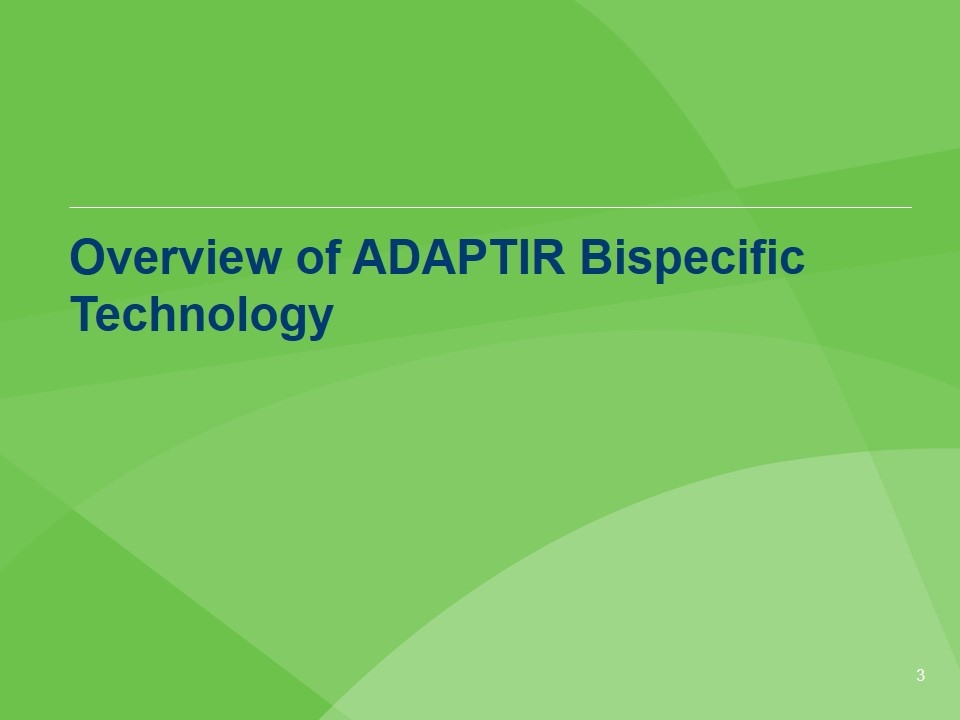
Overview of ADAPTIR Bispecific Technology
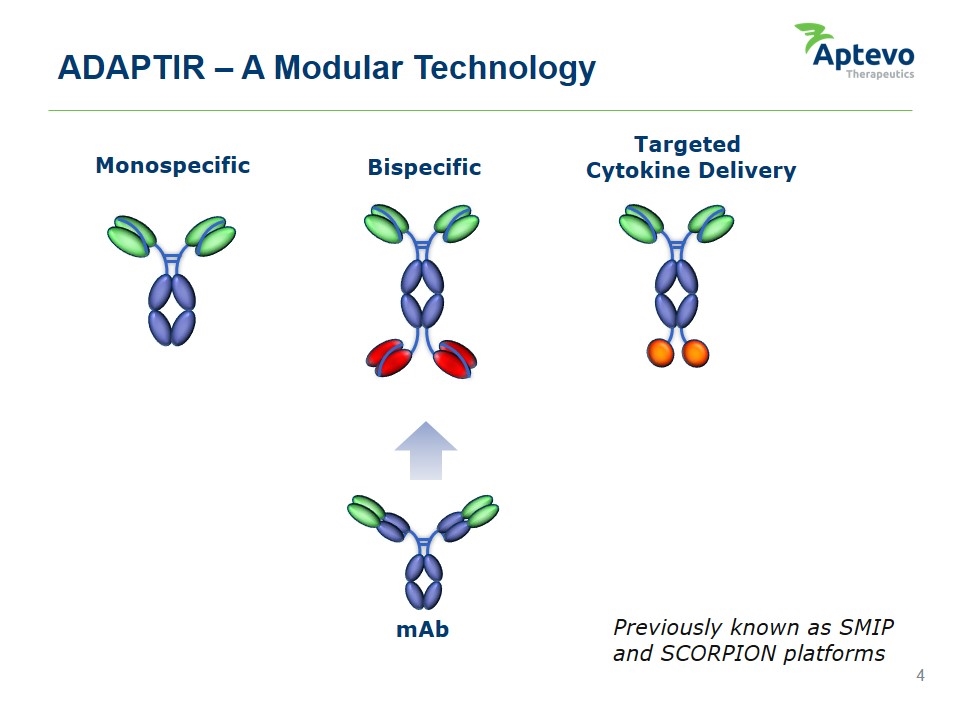
ADAPTIR – A Modular Technology Monospecific mAb Bispecific Targeted Cytokine Delivery Previously known as SMIP and SCORPION platforms
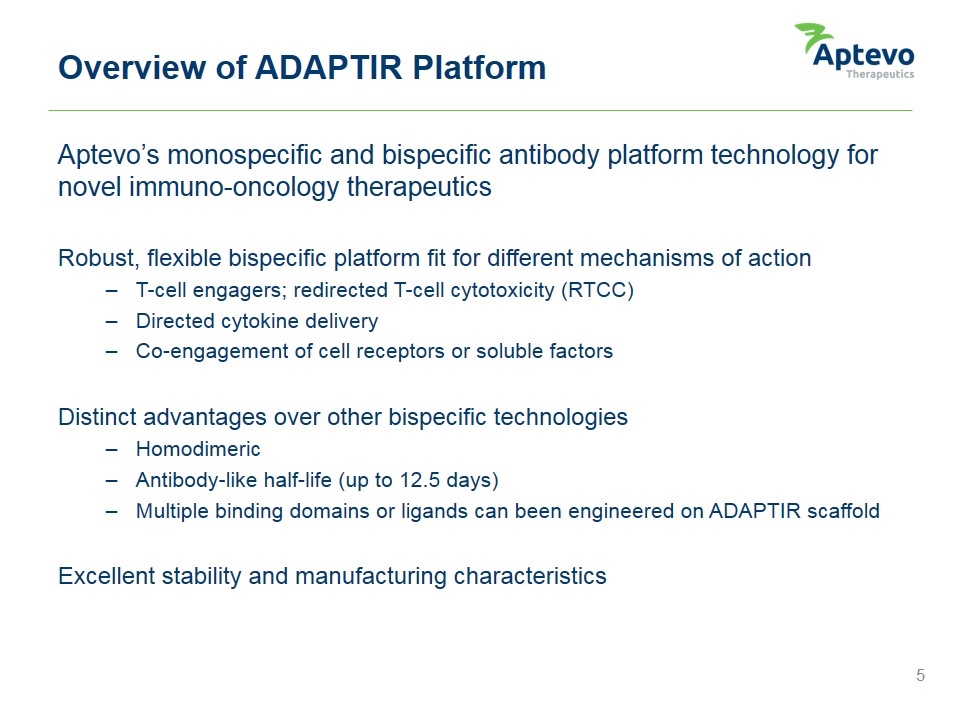
Aptevo’s monospecific and bispecific antibody platform technology for novel immuno-oncology therapeutics Robust, flexible bispecific platform fit for different mechanisms of action T-cell engagers; redirected T-cell cytotoxicity (RTCC) Directed cytokine delivery Co-engagement of cell receptors or soluble factors Distinct advantages over other bispecific technologies Homodimeric Antibody-like half-life (up to 12.5 days) Multiple binding domains or ligands can been engineered on ADAPTIR scaffold Excellent stability and manufacturing characteristics Overview of ADAPTIR Platform
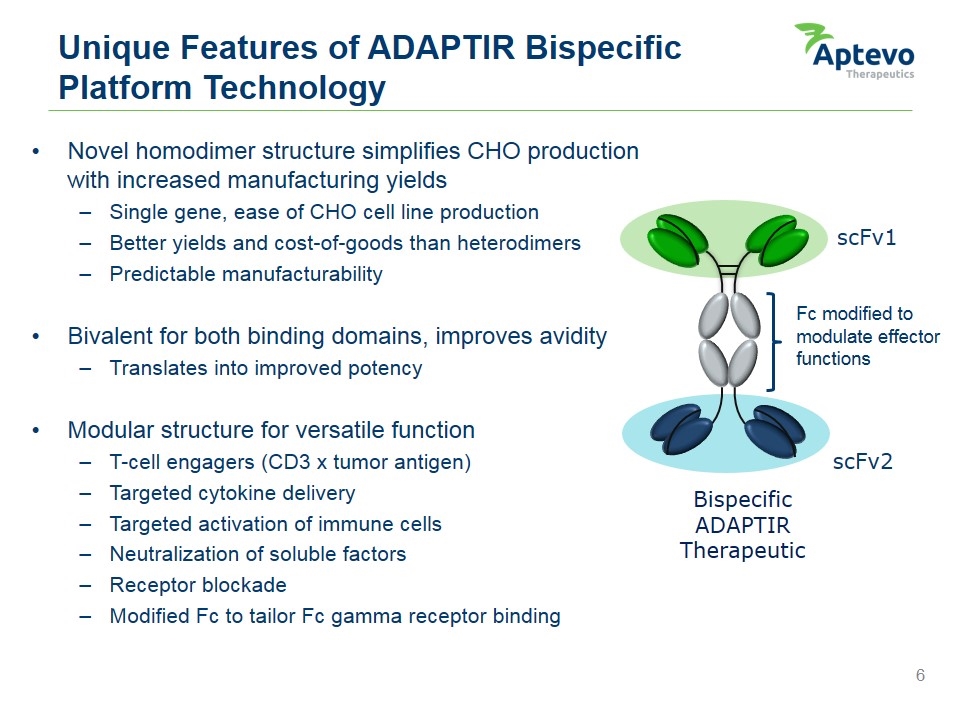
Unique Features of ADAPTIR Bispecific Platform Technology Bispecific ADAPTIR Therapeutic Novel homodimer structure simplifies CHO production with increased manufacturing yields Single gene, ease of CHO cell line production Better yields and cost-of-goods than heterodimers Predictable manufacturability Bivalent for both binding domains, improves avidity Translates into improved potency Modular structure for versatile function T-cell engagers (CD3 x tumor antigen) Targeted cytokine delivery Targeted activation of immune cells Neutralization of soluble factors Receptor blockade Modified Fc to tailor Fc gamma receptor binding scFv1 Fc modified to modulate effector functions scFv2
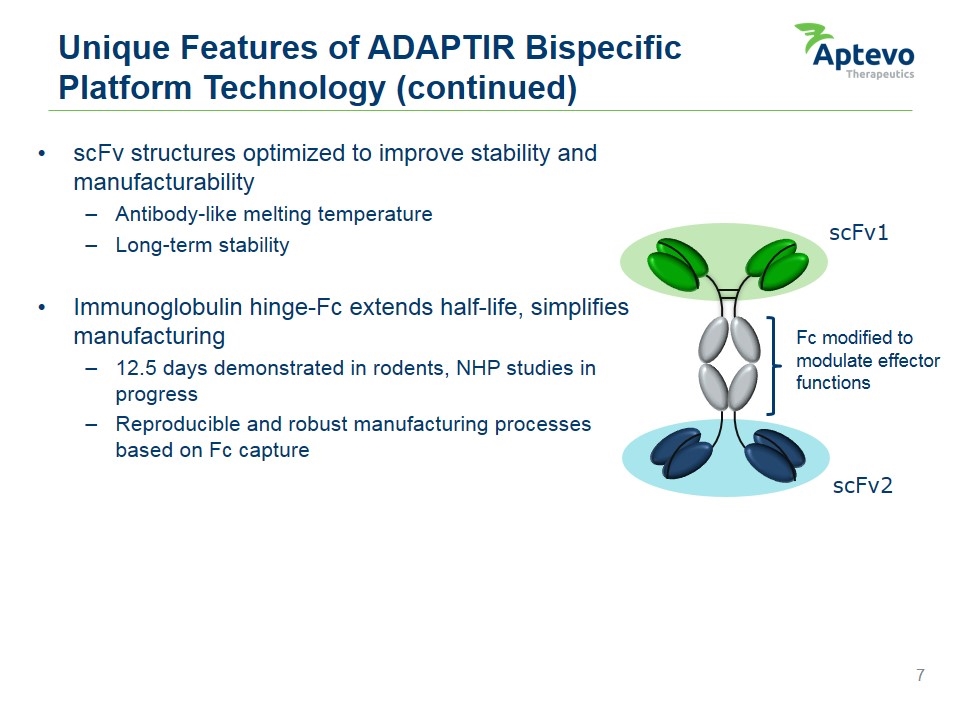
Unique Features of ADAPTIR Bispecific Platform Technology (continued) scFv structures optimized to improve stability and manufacturability Antibody-like melting temperature Long-term stability Immunoglobulin hinge-Fc extends half-life, simplifies manufacturing 12.5 days demonstrated in rodents, NHP studies in progress Reproducible and robust manufacturing processes based on Fc capture scFv1 Fc modified to modulate effector functions scFv2
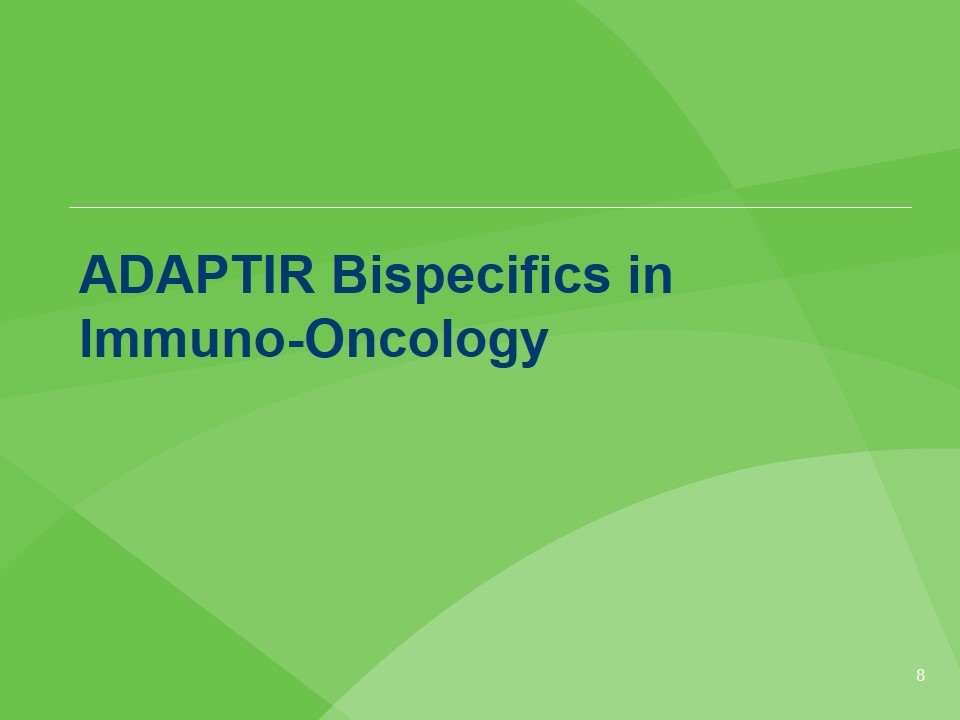
ADAPTIR Bispecifics in Immuno-Oncology
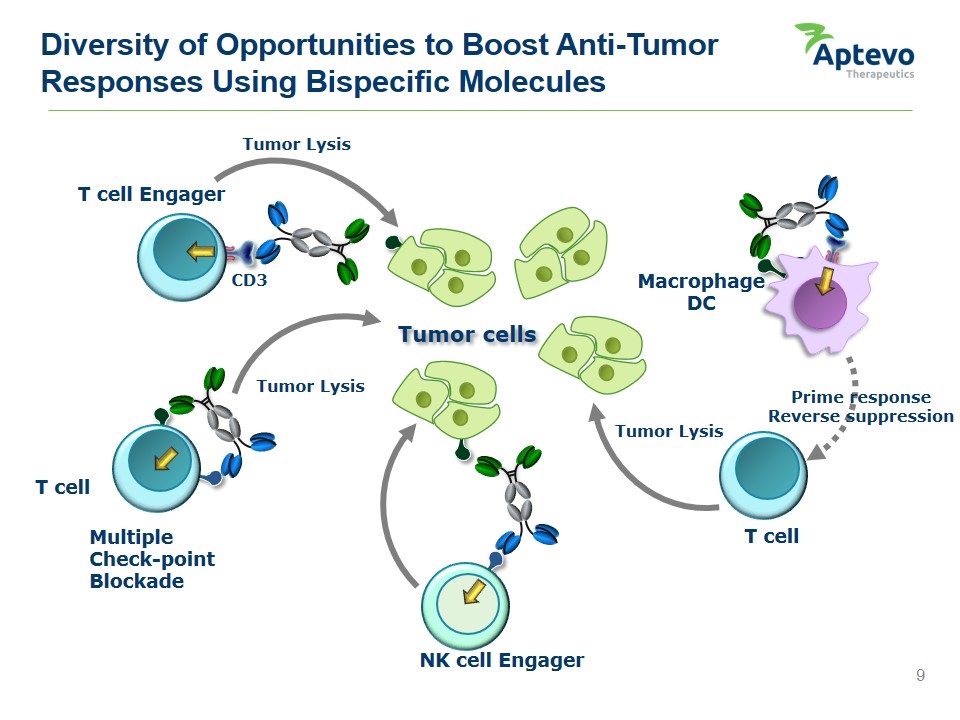
Diversity of Opportunities to Boost Anti-Tumor Responses Using Bispecific Molecules T cell Engager Tumor Lysis NK cell Engager Tumor cells Tumor Lysis T cell Tumor Lysis Prime response Reverse suppression Multiple Check-point Blockade CD3 T cell Macrophage DC

Platform enables multiple modalities to stimulate T-cell function Stimulation of adaptive and innate cell responses Stimulation in trans or cis Engagement of TCR/CD3, costimulatory receptors or cytokine receptors Versatility of Bispecific ADAPTIR Platform T-cell CD3 engagers T-cell co-stimulators Targeted cytokines Induces polyclonal T-cell response Boosts endogenous T-cell response Boosts endogenous adaptive/innate response ‘Cis’ signaling ‘Trans’ signaling ‘Trans’ signaling
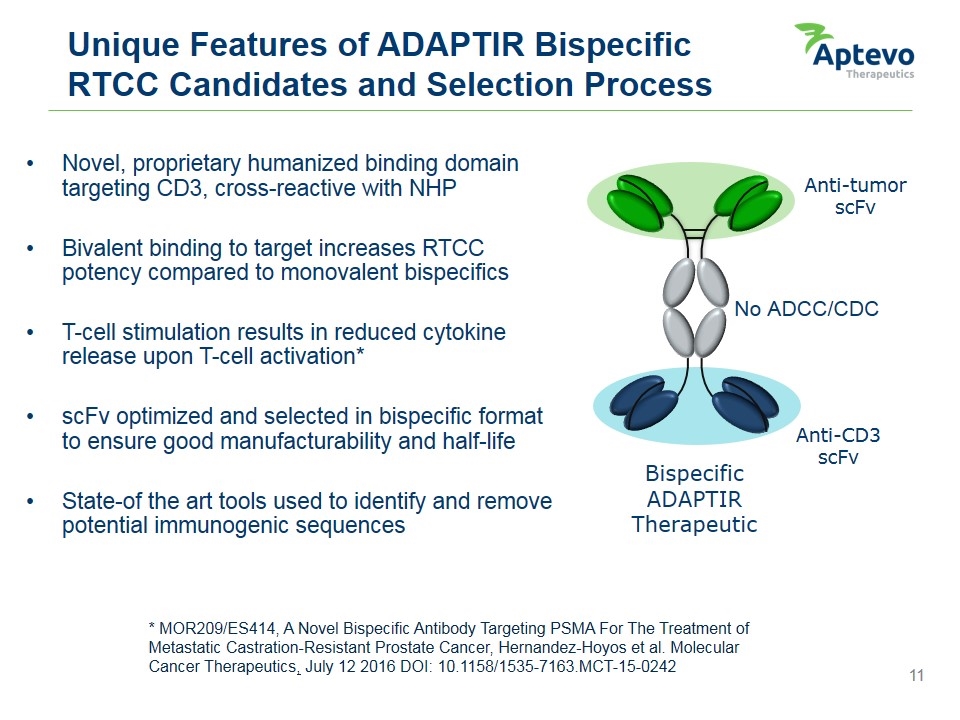
Bispecific ADAPTIR Therapeutic Anti-tumor scFv Anti-CD3 scFv No ADCC/CDC * MOR209/ES414, A Novel Bispecific Antibody Targeting PSMA For The Treatment of Metastatic Castration-Resistant Prostate Cancer, Hernandez-Hoyos et al. Molecular Cancer Therapeutics, July 12 2016 DOI: 10.1158/1535-7163.MCT-15-0242 Unique Features of ADAPTIR Bispecific RTCC Candidates and Selection Process Novel, proprietary humanized binding domain targeting CD3, cross-reactive with NHP Bivalent binding to target increases RTCC potency compared to monovalent bispecifics T-cell stimulation results in reduced cytokine release upon T-cell activation* scFv optimized and selected in bispecific format to ensure good manufacturability and half-life State-of the art tools used to identify and remove potential immunogenic sequences
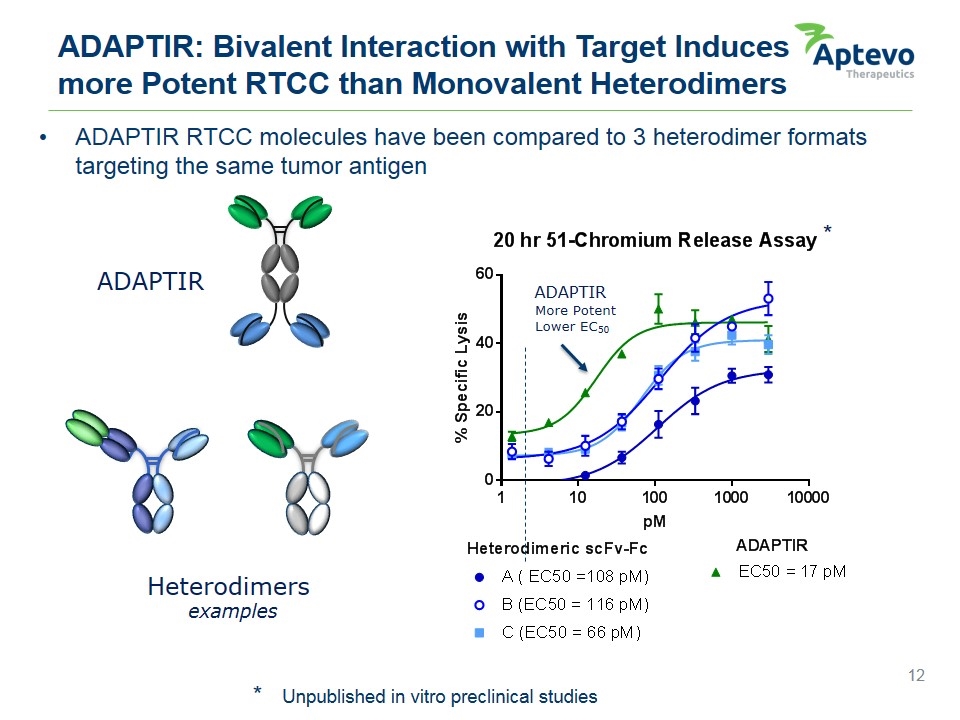
ADAPTIR RTCC molecules have been compared to 3 heterodimer formats targeting the same tumor antigen ADAPTIR More Potent Lower EC50 ADAPTIR Heterodimers examples * Unpublished in vitro preclinical studies * ADAPTIR: Bivalent Interaction with Target Induces more Potent RTCC than Monovalent Heterodimers 20 hr 51-chromium release assay* % Specific Lysis 0 20 40 60 1 10 100 1000 1000 ADAPTIR More Potent Lower EC50 pM Heterodimeric scFv-Fc ADAPTIR A (EC50 =108 pM) B (EC50 = 116 pM) C (EC50 = 66 pM) EC50 = 17pM
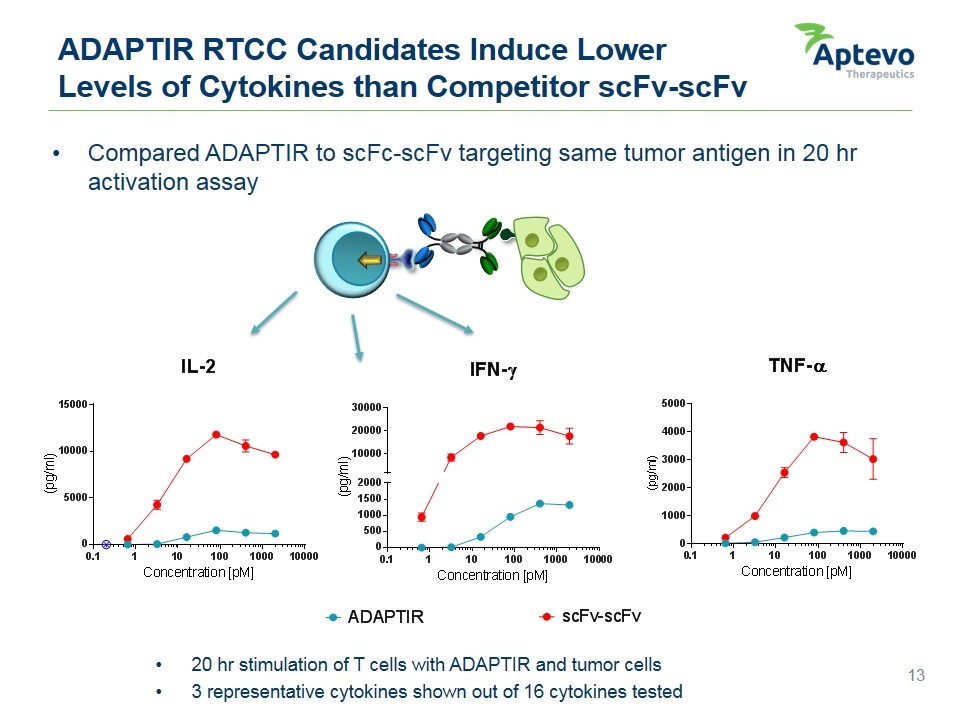
ADAPTIR RTCC Candidates Induce Lower Levels of Cytokines than Competitor scFv-scFv 20 hr stimulation of T cells with ADAPTIR and tumor cells 3 representative cytokines shown out of 16 cytokines tested Compared ADAPTIR to scFc-scFv targeting same tumor antigen in 20 hr activation assay IL-2 15000 10000 5000 0 (pg/ml) 0.1 1 10 100 1000 10000 Concentration [pM] IFN-y 30000 20000 10000 2000 1500 1000 500 0 0.1 1 12 100 1000 10000 Concentration [pM] TNF-a 5000 4000 3000 2000 1000 0 0.1 1 10 100 1000 10000 Concentration [pM] ADAPTIR scFv-scFv
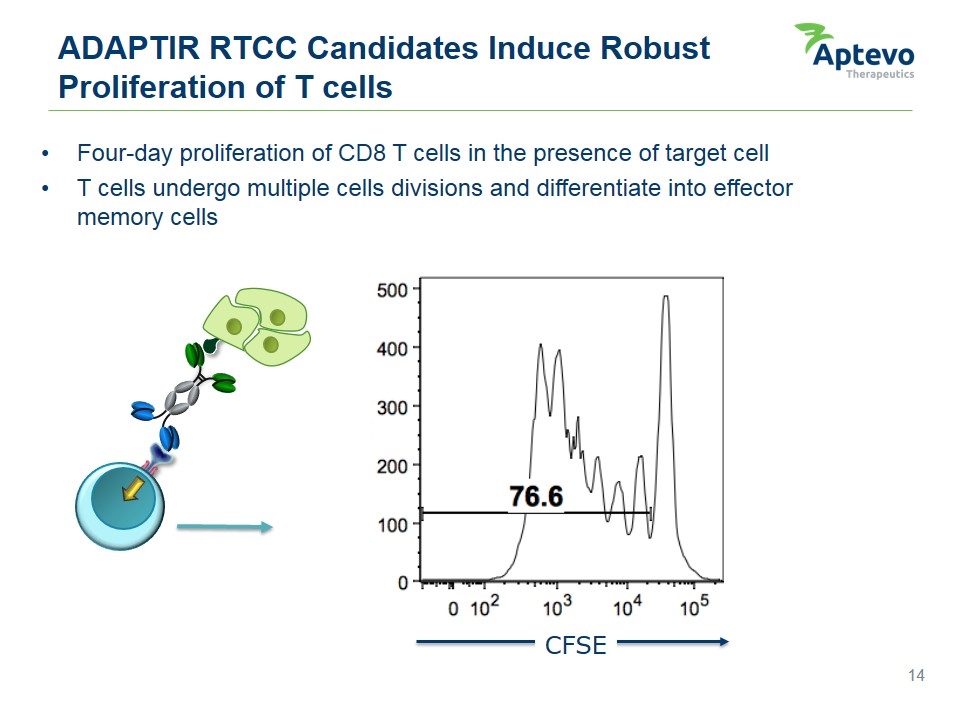
Four-day proliferation of CD8 T cells in the presence of target cell T cells undergo multiple cells divisions and differentiate into effector memory cells ADAPTIR RTCC Candidates Induce Robust Proliferation of T cells CFSE 500 400 300 200 100 0 0 102 103 104 105 CFSE 76.6
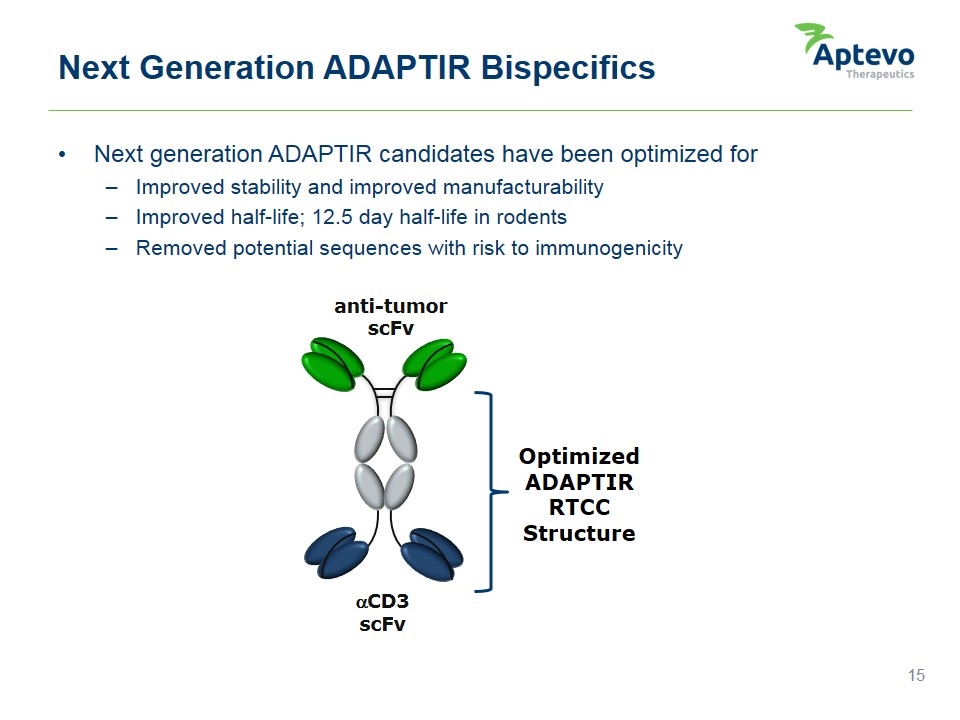
Next generation ADAPTIR candidates have been optimized for Improved stability and improved manufacturability Improved half-life; 12.5 day half-life in rodents Removed potential sequences with risk to immunogenicity Next Generation ADAPTIR Bispecifics anti-tumor scFv aCD3 scFv Optimized ADAPTIR RTCC Structure
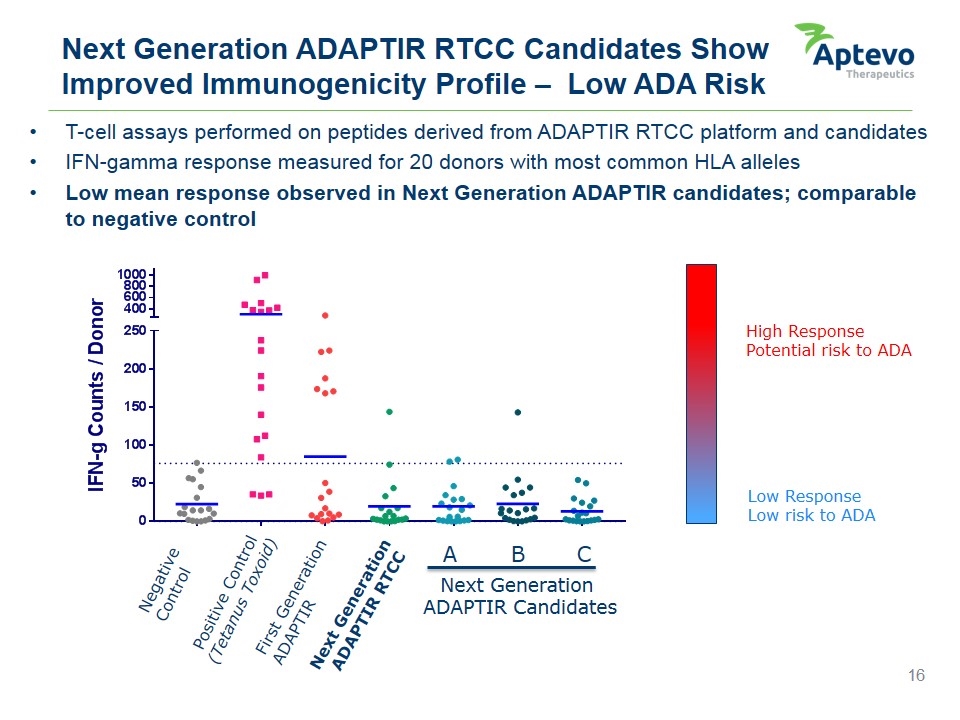
Next Generation ADAPTIR RTCC Candidates Show Improved Immunogenicity Profile – Low ADA Risk T-cell assays performed on peptides derived from ADAPTIR RTCC platform and candidates IFN-gamma response measured for 20 donors with most common HLA alleles Low mean response observed in Next Generation ADAPTIR candidates; comparable to negative control Negative Control Positive Control (Tetanus Toxoid) First Generation ADAPTIR Next Generation ADAPTIR RTCC A B C Next Generation ADAPTIR Candidates High Response Potential risk to ADA Low Response Low risk to ADA IFN-g Counts donor 1000 800 600 400 250 200 150 100 50 0

ADAPTIR Portfolio of Candidates
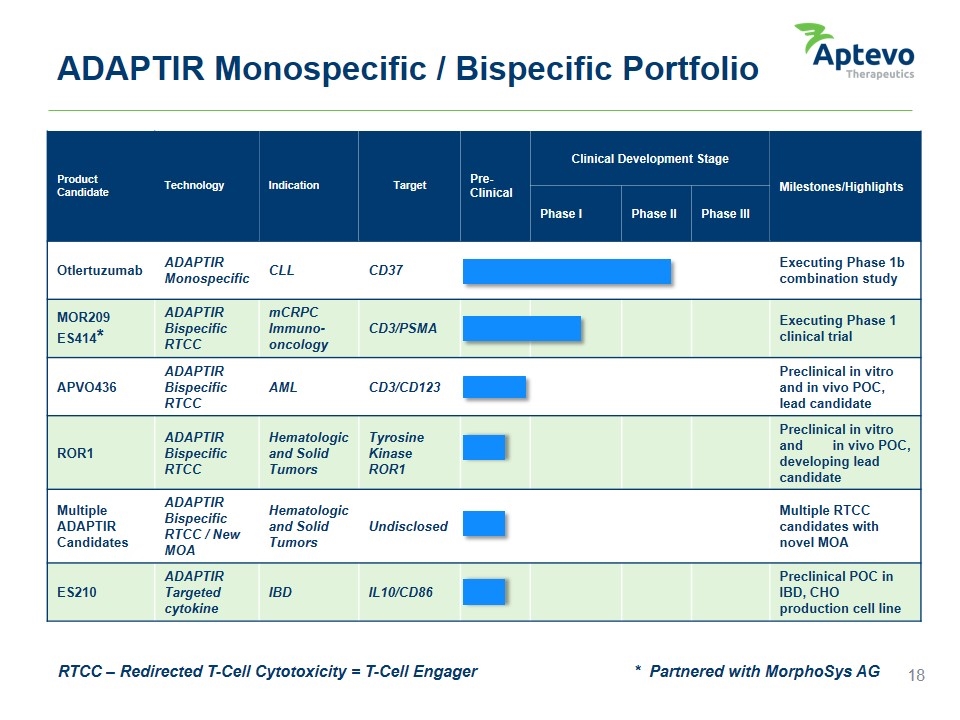
Product Candidate Technology Indication Target Pre-Clinical Clinical Development Stage Milestones/Highlights Phase I Phase II Phase III Otlertuzumab ADAPTIR Monospecific CLL CD37 Executing Phase 1b combination study MOR209 ES414* ADAPTIR Bispecific RTCC mCRPC Immuno-oncology CD3/PSMA Executing Phase 1 clinical trial APVO436 ADAPTIR Bispecific RTCC AML CD3/CD123 Preclinical in vitro and in vivo POC, lead candidate ROR1 ADAPTIR Bispecific RTCC Hematologic and Solid Tumors Tyrosine Kinase ROR1 Preclinical in vitro and in vivo POC, developing lead candidate Multiple ADAPTIR Candidates ADAPTIR Bispecific RTCC / New MOA Hematologic and Solid Tumors Undisclosed Multiple RTCC candidates with novel MOA ES210 ADAPTIR Targeted cytokine IBD IL10/CD86 Preclinical POC in IBD, CHO production cell line ADAPTIR Monospecific / Bispecific Portfolio * Partnered with MorphoSys AG RTCC – Redirected T-Cell Cytotoxicity = T-Cell Engager

Clinical Candidate – otlertuzumab (CLL) aCD37 scFv Human IgG1 Fc Humanized monospecific protein therapeutic Targets CD37 and its signaling pathway involved in B-cell malignancies Built on ADAPTIR (modular protein therapeutic) platform Demonstrated anti-tumor activity Prolonged serum half-life (mouse /NHP) vs antibody fragments 100% owned by Aptevo Actively pursuing potential partnership opportunities 253 subjects treated to date; appears safe and well tolerated Ongoing: Phase 2 study for chronic lymphocytic leukemia (CLL) Combination with ibrutinib Preliminary data read-out anticipated in H2 2017 Multiple clinical trial data published, establishing clinical proof-of-concept PHASE 2 STUDY (16201): Combination of otlertuzumab + bendamustine PHASE 1b STUDY (16009): Combination of otlertuzumab + rituximab Description Partnering Development Status
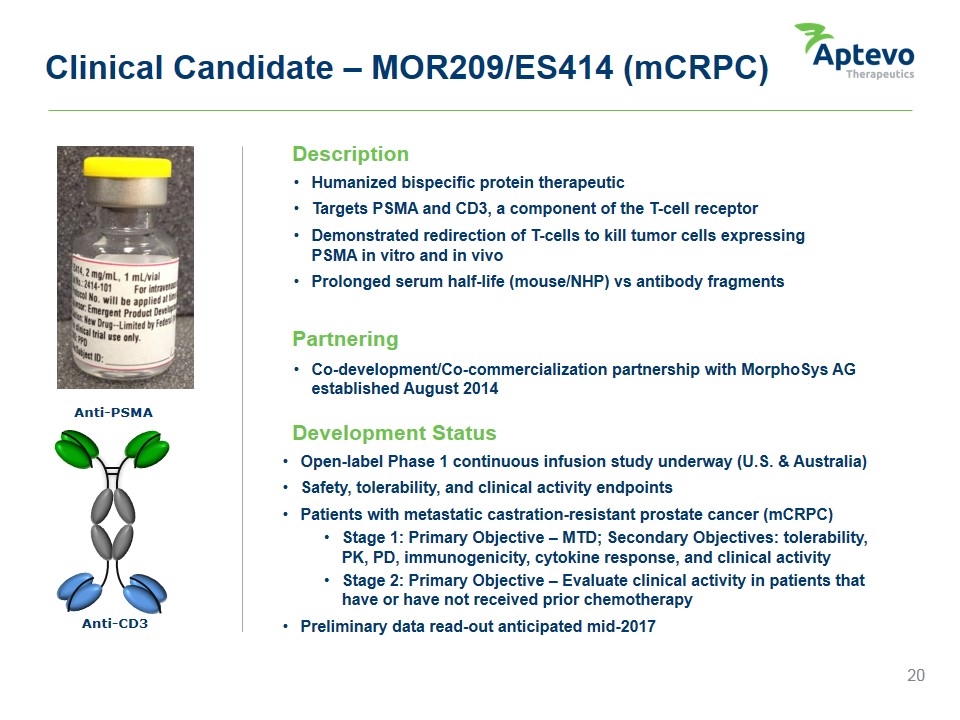
Clinical Candidate – MOR209/ES414 (mCRPC) Anti-PSMA Anti-CD3 Humanized bispecific protein therapeutic Targets PSMA and CD3, a component of the T-cell receptor Demonstrated redirection of T-cells to kill tumor cells expressing PSMA in vitro and in vivo Prolonged serum half-life (mouse/NHP) vs antibody fragments Co-development/Co-commercialization partnership with MorphoSys AG established August 2014 Open-label Phase 1 continuous infusion study underway (U.S. & Australia) Safety, tolerability, and clinical activity endpoints Patients with metastatic castration-resistant prostate cancer (mCRPC) Stage 1: Primary Objective – MTD; Secondary Objectives: tolerability, PK, PD, immunogenicity, cytokine response, and clinical activity Stage 2: Primary Objective – Evaluate clinical activity in patients that have or have not received prior chemotherapy Preliminary data read-out anticipated mid-2017 Description Partnering Development Status

ADAPTIR Preclinical Candidates
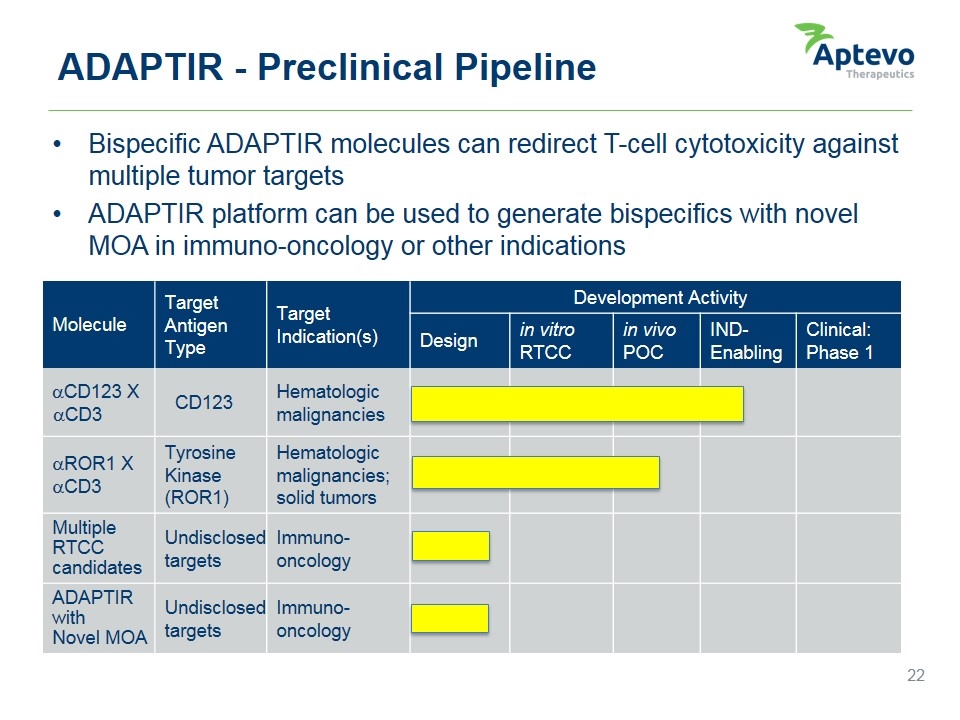
ADAPTIR - Preclinical Pipeline Molecule Target Antigen Type Target Indication(s) Development Activity Design in vitro RTCC in vivo POC IND-Enabling Clinical: Phase 1 aCD123 X aCD3 CD123 Hematologic malignancies aROR1 X aCD3 Tyrosine Kinase (ROR1) Hematologic malignancies; solid tumors Multiple RTCC candidates Undisclosed targets Immuno-oncology ADAPTIR with Novel MOA Undisclosed targets Immuno-oncology Bispecific ADAPTIR molecules can redirect T-cell cytotoxicity against multiple tumor targets ADAPTIR platform can be used to generate bispecifics with novel MOA in immuno-oncology or other indications
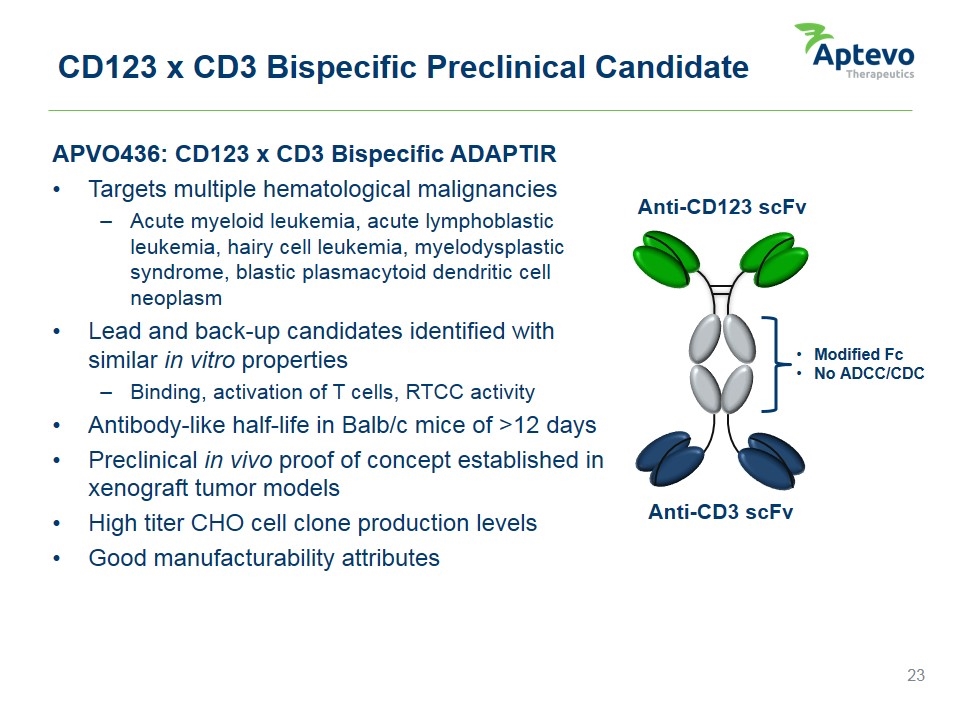
APVO436: CD123 x CD3 Bispecific ADAPTIR Targets multiple hematological malignancies Acute myeloid leukemia, acute lymphoblastic leukemia, hairy cell leukemia, myelodysplastic syndrome, blastic plasmacytoid dendritic cell neoplasm Lead and back-up candidates identified with similar in vitro properties Binding, activation of T cells, RTCC activity Antibody-like half-life in Balb/c mice of >12 days Preclinical in vivo proof of concept established in xenograft tumor models High titer CHO cell clone production levels Good manufacturability attributes CD123 x CD3 Bispecific Preclinical Candidate Anti-CD3 scFv Anti-CD123 scFv Modified Fc No ADCC/CDC
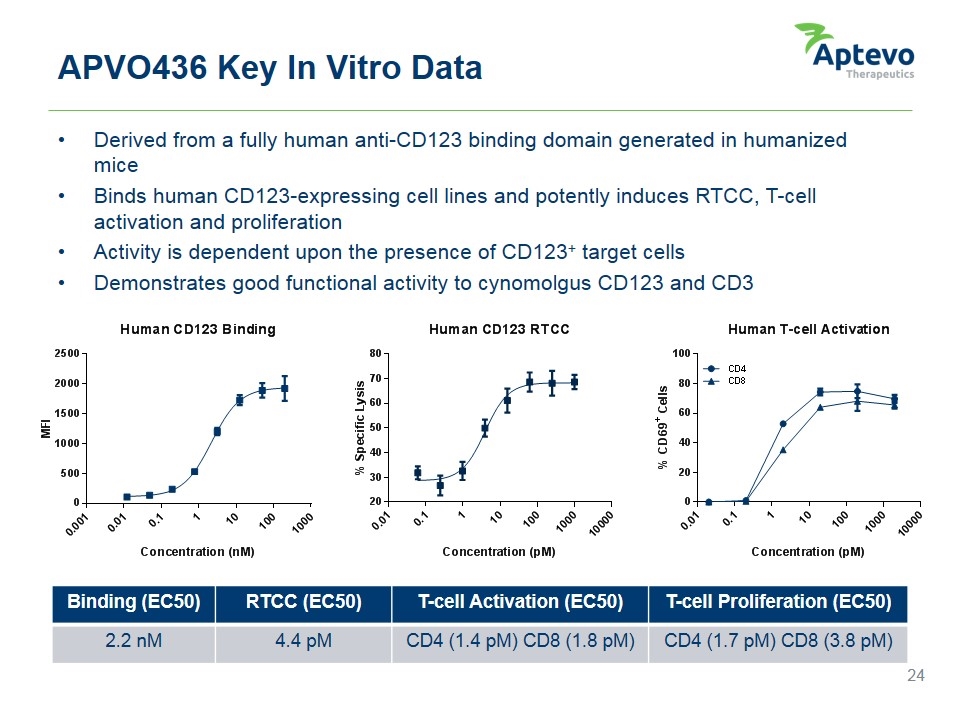
Derived from a fully human anti-CD123 binding domain generated in humanized mice Binds human CD123-expressing cell lines and potently induces RTCC, T-cell activation and proliferation Activity is dependent upon the presence of CD123+ target cells Demonstrates good functional activity to cynomolgus CD123 and CD3 APVO436 Key In Vitro Data Binding (EC50) RTCC (EC50) T-cell Activation (EC50) T-cell Proliferation (EC50) 2.2 nM 4.4 pM CD4 (1.4 pM) CD8 (1.8 pM) CD4 (1.7 pM) CD8 (3.8 pM) Human CD123 Binding 2500 2000 1500 1000 500 0 0.001 0.01 0.1 1 10 100 1000 MFI Concentration (nM) Human CD123 RTCC % Specific Lysis 80 70 60 50 40 30 20 0.01 0.1 1 10 100 1000 Concentration (pM) Human T-cell Activation % CD69+ Cells CD4 CD8 100 80 60 40 20 0 0.01 0.1 1 10 100 1000 10000 Conentration (pM)
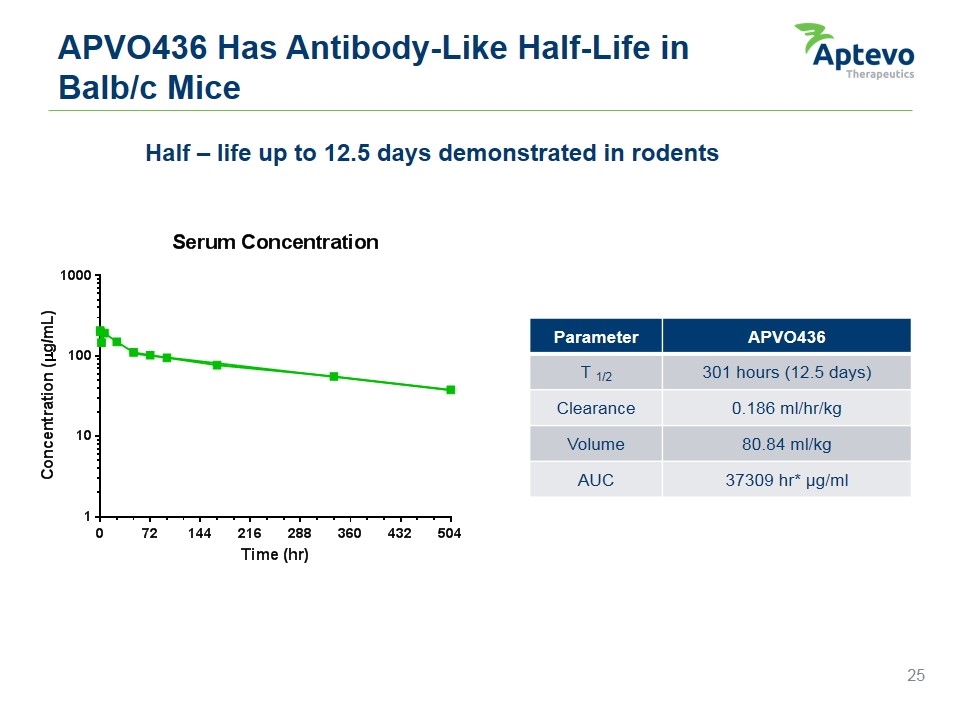
APVO436 Has Antibody-Like Half-Life in Balb/c Mice Half – life up to 12.5 days demonstrated in rodents Parameter APVO436 T 1/2 301 hours (12.5 days) Clearance 0.186 ml/hr/kg Volume 80.84 ml/kg AUC 37309 hr* µg/ml Concentration (μg/mL) Serum Concentration 1000 100 10 1 0 72 177 216 288 360 432 504 Time (hr)

APVO436 Inhibits Tumor Growth in Xenograft Model of Human AML Day 11: APVO436, 0.6 mg Group (Tumor + T cells) Day 11: Vehicle Control Group (Tumor + T cells) Growth of MOLM-13/LUC Cells (Bioluminescence Imaging) Bioluminescence Total Flux [p/s] 1010 019 108 107 106 0 2 4 6 8 10 12 Days post tum or cells engraftment APVO436 / APVO437 Treatment Molm-13 + T-cells/Vehicle Control Molm-13 only/Vehicle Control Molm-13 T-cells/APVO436, 15 μg Molm-13 + T-cells/APVO436, 3 μg Molm-13 + T-cells/APVO436, 0.6 μg Molm-13 only/APVO436, 3 μg Luminescence 5.0 4.0 3.0 2.0 1.0 x108 Radiance (p/sec/cm2/sr) Color Scale Min = 3.00e6 Max = 5.00e8

APVO436 Prolongs Survival in Xenograft Model of Human AML Treatment Group Median Survival Time (Days) Survival Relative to Molm-13 + T cells/Vehicle Control (P value) Molm-13 + T cells/Vehicle 17 (-) Molm-13 + T cells/APVO346 15 µg Undefined <0.0001 Molm-13 + T cells/APVO346 3 µg Undefined <0.0001 Molm-13 + T cells/APVO346 0.6 µg Undefined <0.0001 Molm-13 only/Vehicle 17 0.5136 Molm-13 only/APVO346 17 0.0772 Percent survival 100 80 60 40 20 0 0 4 8 12 16 20 24 28 32 36 Days post tumor challenge Molm-13 + T-cells/APVO436, 15 μg Molm-13 + T-cells/APVO436, 3 μg Molm-13 + T-cells/APVO436, 0.6 μg Molm-13 only/APVO436, 0.6 μg Molm-13 + T-cells/Vehicle Control Molm-13 only/Vehicle Control
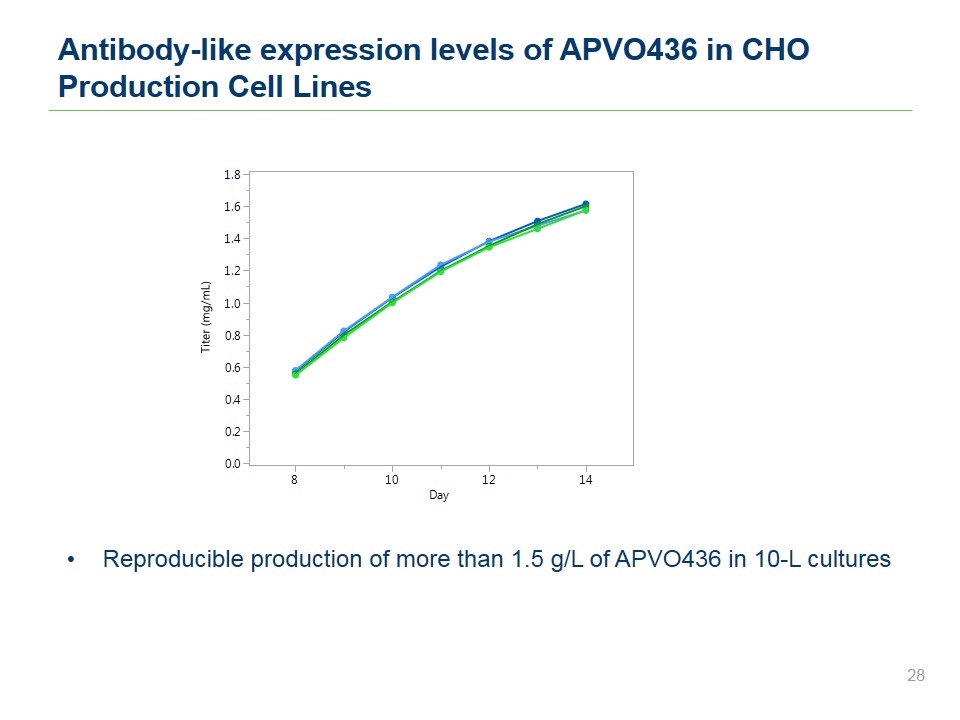
Reproducible production of more than 1.5 g/L of APVO436 in 10-L cultures Antibody-like expression levels of APVO436 in CHO Production Cell Lines Titer (mg/mL) 1.8 1.6 1.4 1.2 1.0 0.8 0.6 0.4 0.2 0.0 8 10 12 14 Day
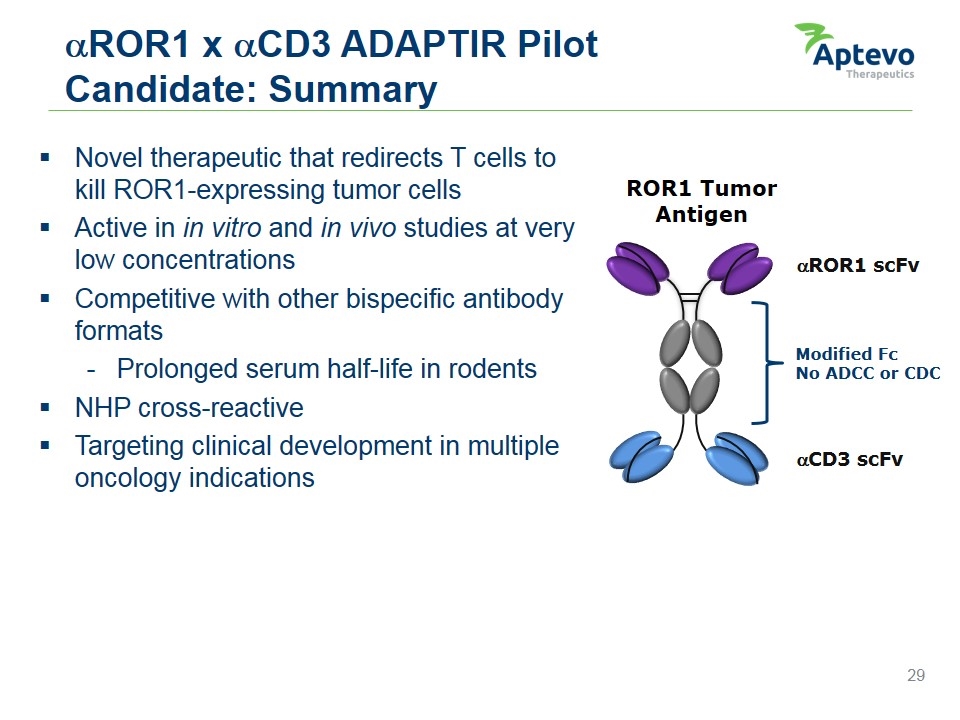
aROR1 x aCD3 ADAPTIR Pilot Candidate: Summary aROR1 scFv aCD3 scFv ROR1 Tumor Antigen Modified Fc No ADCC or CDC Novel therapeutic that redirects T cells to kill ROR1-expressing tumor cells Active in in vitro and in vivo studies at very low concentrations Competitive with other bispecific antibody formats Prolonged serum half-life in rodents NHP cross-reactive Targeting clinical development in multiple oncology indications
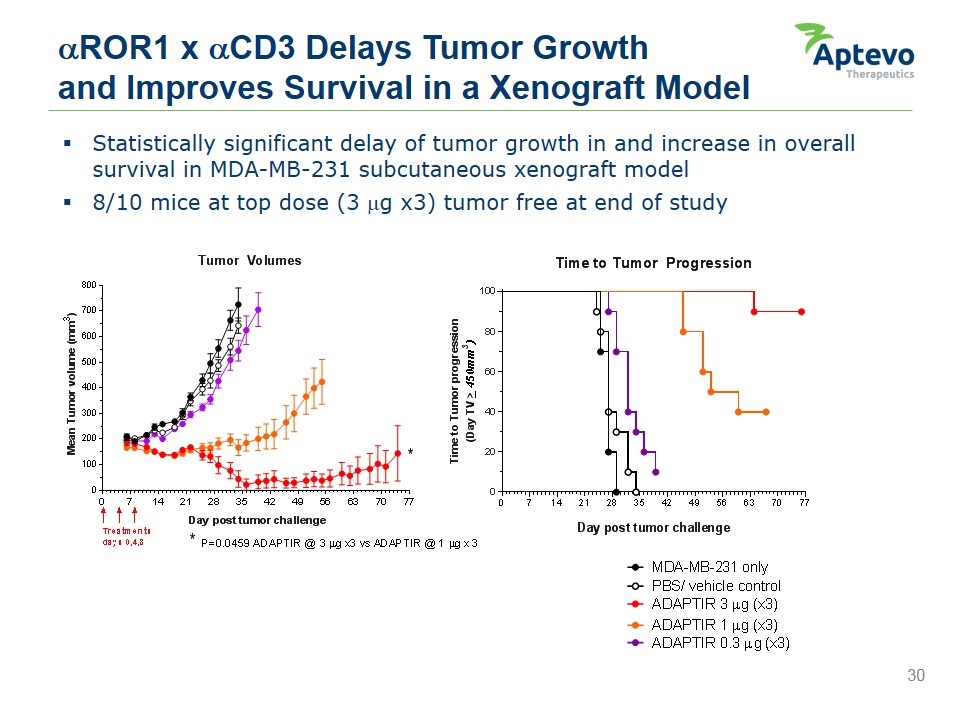
aROR1 x aCD3 Delays Tumor Growth and Improves Survival in a Xenograft Model Statistically significant delay of tumor growth in and increase in overall survival in MDA-MB-231 subcutaneous xenograft model 8/10 mice at top dose (3 mg x3) tumor free at end of study Tumor Volumes Mean Tumor Volume (mm3) 800 700 600 500 400 300 200 100 0 0 7 14 21 28 35 42 49 56 63 70 77 Day post tumor challenge Treatments days 0,4,8 *P=0.0459 ADAPTIR @ 3 μg x3 vs ADAPTIR @ 1 μg x 3 Time to Tumor Progression Time to Tumor progression (Day TV > 450mm3) 100 80 60 40 20 0 0 7 14 21 28 35 42 49 56 63 70 77 Day post tumor challenge MDA-MB-231 only PBS/vehicle control ADAPTIR 3 μg (x3) ADAPTIR 1 μg (x3) ADAPTIRE 0.3 μg (x3)
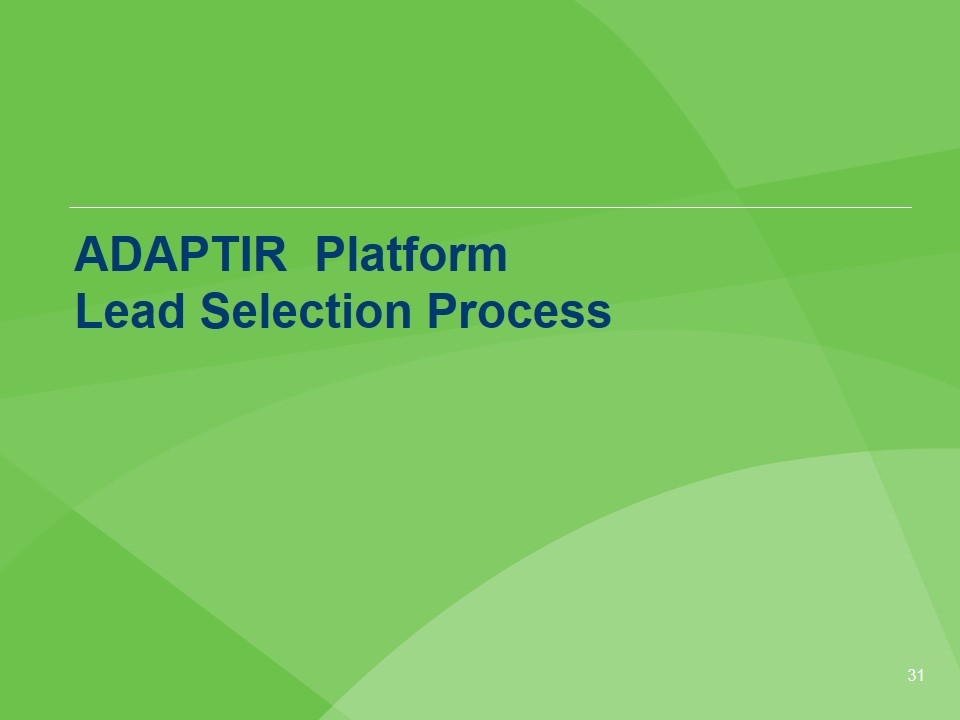
ADAPTIR Platform Lead Selection Process
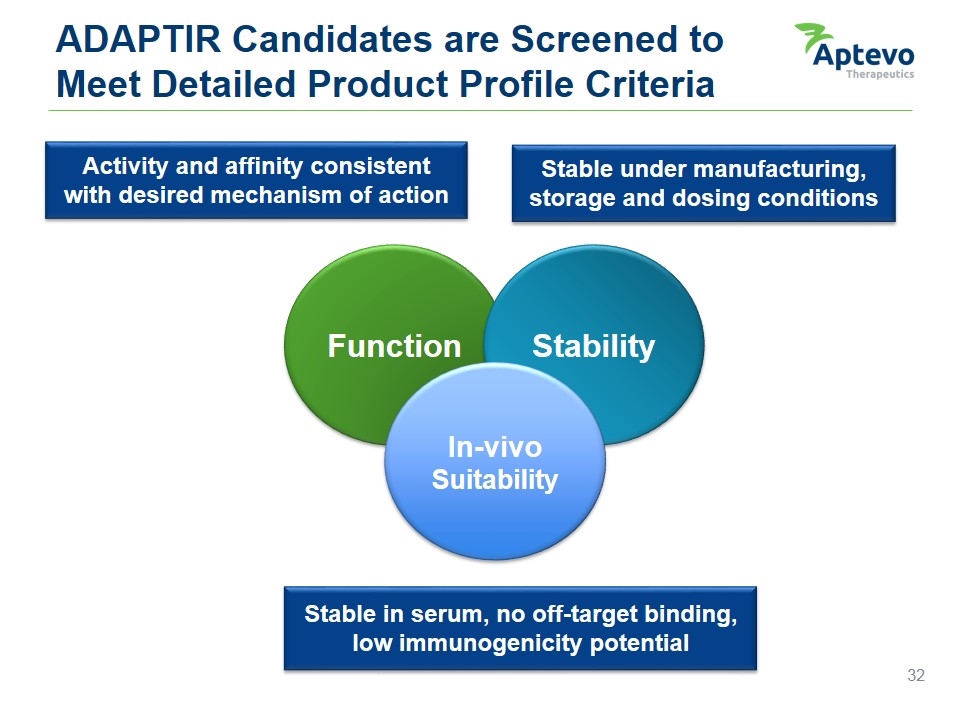
Activity and affinity consistent with desired mechanism of action ADAPTIR Candidates are Screened to Meet Detailed Product Profile Criteria Function Stability In-vivo Suitability Stable under manufacturing, storage and dosing conditions Stable in serum, no off-target binding, low immunogenicity potential

scFv domains obtained from human phage library to leverage stable IgG frameworks, or humanized rodents to leverage high affinity human binding domains High throughput screening and characterization assays are performed in ADAPTIR format scFv must achieve Tm >60 °C without reliance on additional stabilizing disulfides Example of 8 ADAPTIR candidates selected against a single antigen shows multiple scFvs with desired stability criteria: Screening and Optimization of Stable scFvs Enables mAb-like Performance Molecule scFv1 Tm, °C ADAPTIR “M” 70 ADAPTIR “N” 79 ADAPTIR “O” 64 ADAPTIR “P” 65 Molecule scFv1 Tm, °C ADAPTIR “R” 73 ADAPTIR “S” 70 ADAPTIR “T” 69 ADAPTIR “U” 74
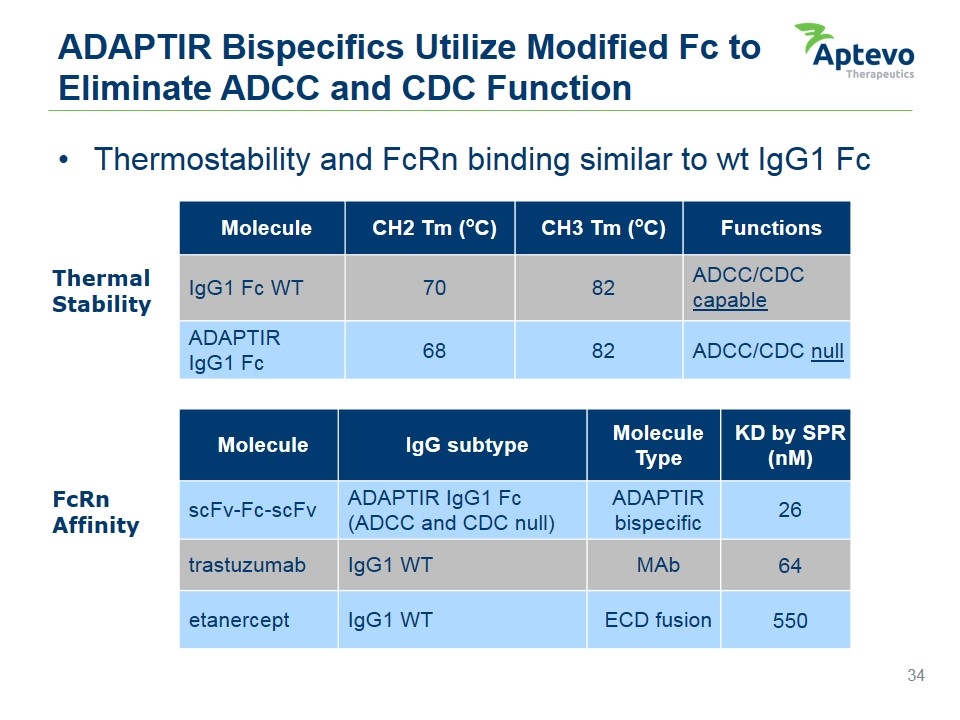
Thermostability and FcRn binding similar to wt IgG1 Fc ADAPTIR Bispecifics Utilize Modified Fc to Eliminate ADCC and CDC Function Molecule IgG subtype Molecule Type KD by SPR (nM) scFv-Fc-scFv ADAPTIR IgG1 Fc (ADCC and CDC null) ADAPTIR bispecific 26 trastuzumab IgG1 WT MAb 64 etanercept IgG1 WT ECD fusion 550 Thermal Stability FcRn Affinity Molecule CH2 Tm (oC) CH3 Tm (oC) Functions IgG1 Fc WT 70 82 ADCC/CDC capable ADAPTIR IgG1 Fc 68 82 ADCC/CDC null
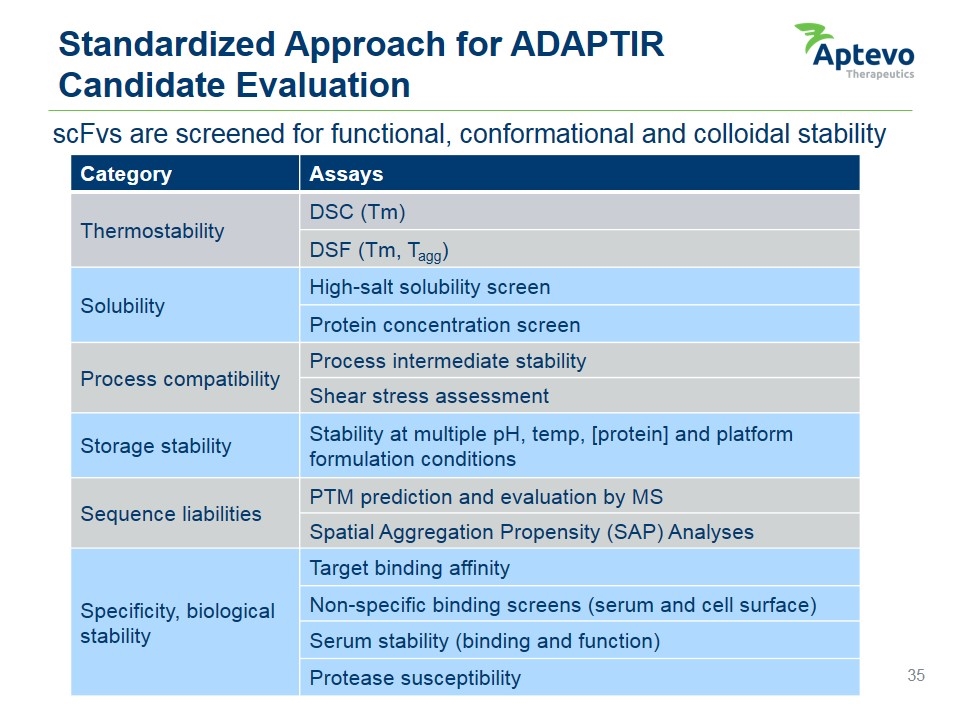
Standardized Approach for ADAPTIR Candidate Evaluation scFvs are screened for functional, conformational and colloidal stability Category Assays Thermostability DSC (Tm) DSF (Tm, Tagg) Solubility High-salt solubility screen Protein concentration screen Process compatibility Process intermediate stability Shear stress assessment Storage stability Stability at multiple pH, temp, [protein] and platform formulation conditions Sequence liabilities PTM prediction and evaluation by MS Spatial Aggregation Propensity (SAP) Analyses Specificity, biological stability Target binding affinity Non-specific binding screens (serum and cell surface) Serum stability (binding and function) Protease susceptibility
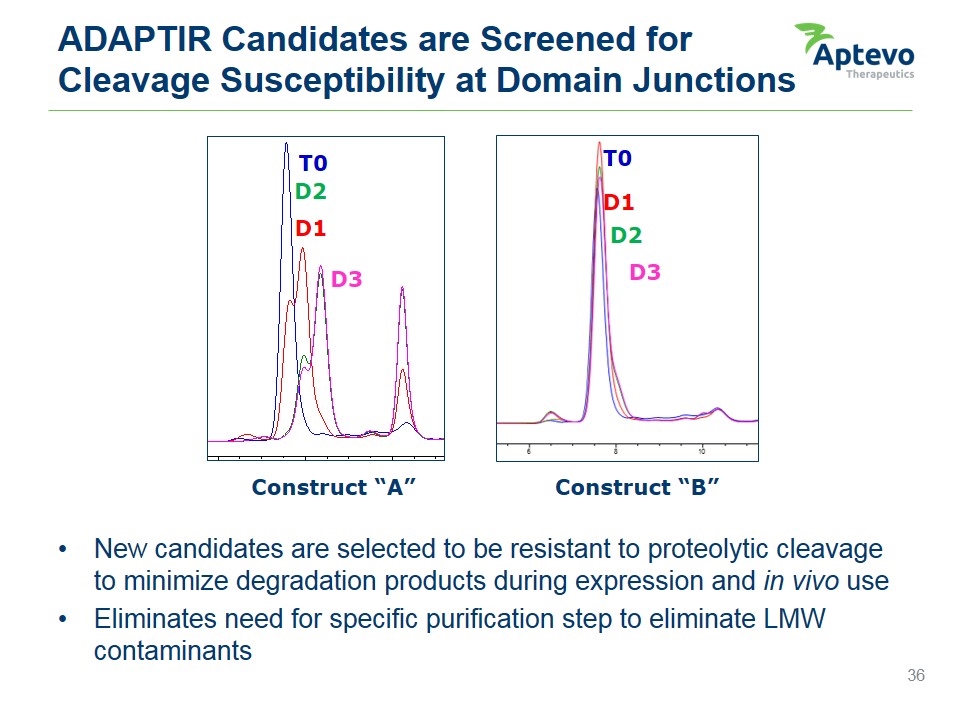
ADAPTIR Candidates are Screened for Cleavage Susceptibility at Domain Junctions D6* T0 D1 D2 D3 D1 D2 D3 Construct “B” T0 Construct “A” New candidates are selected to be resistant to proteolytic cleavage to minimize degradation products during expression and in vivo use Eliminates need for specific purification step to eliminate LMW contaminants
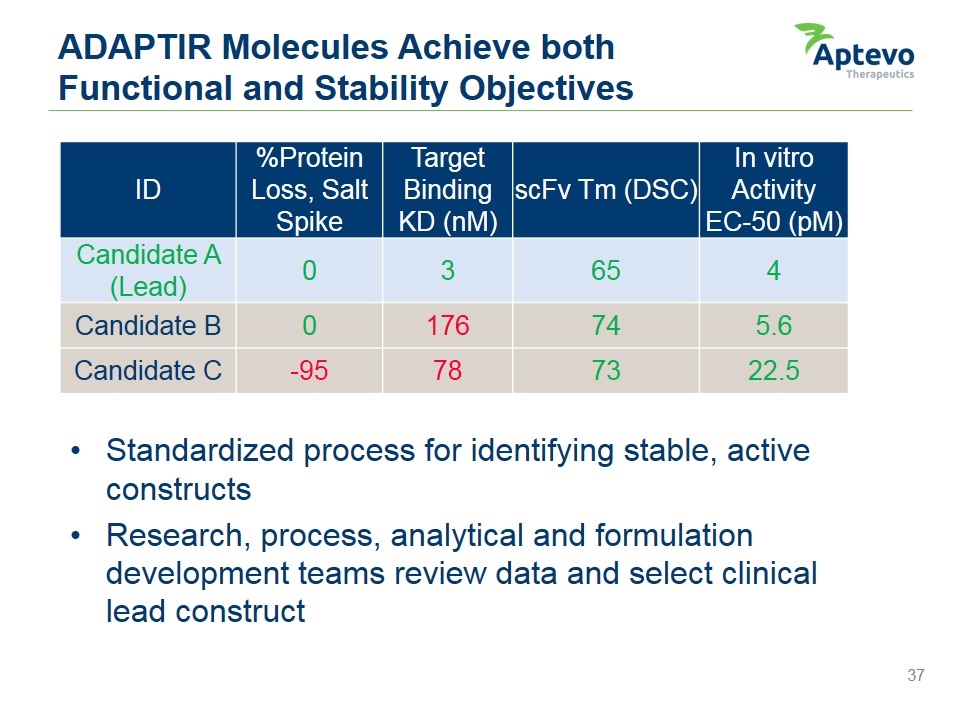
ADAPTIR Molecules Achieve both Functional and Stability Objectives Standardized process for identifying stable, active constructs Research, process, analytical and formulation development teams review data and select clinical lead construct ID %Protein Loss, Salt Spike Target Binding KD (nM) scFv Tm (DSC) In vitro Activity EC-50 (pM) Candidate A (Lead) 0 3 65 4 Candidate B 0 176 74 5.6 Candidate C -95 78 73 22.5
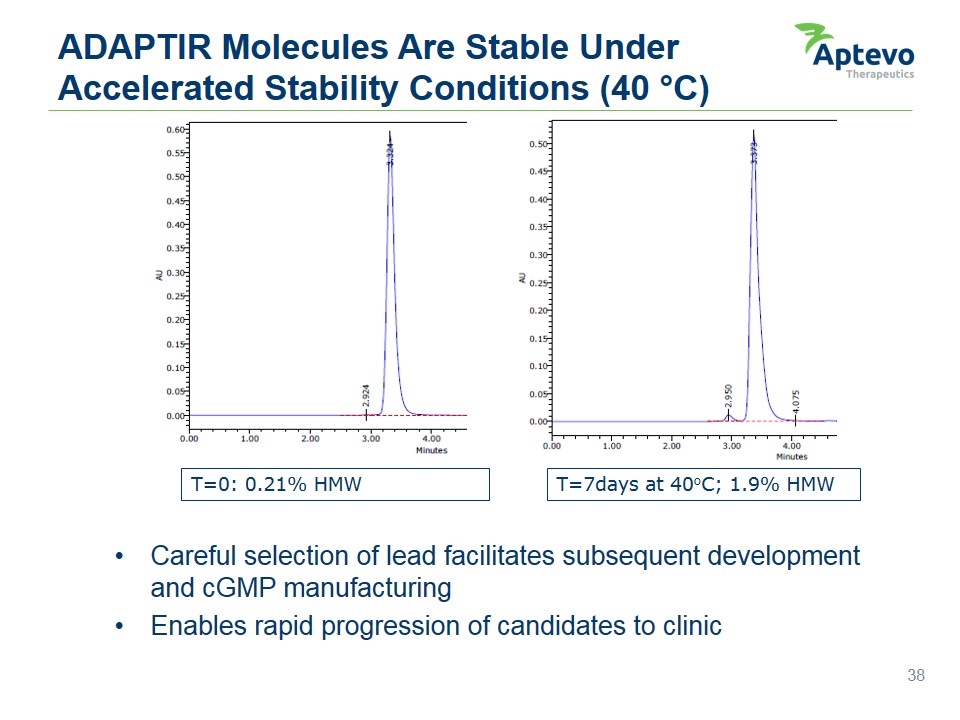
ADAPTIR Molecules Are Stable Under Accelerated Stability Conditions (40 °C) T=0: 0.21% HMW T=7days at 40oC; 1.9% HMW Careful selection of lead facilitates subsequent development and cGMP manufacturing Enables rapid progression of candidates to clinic 0.60 0.55 0.50 0.45 .040 0.35 0.30 0.25 .020 0.15 0.10 0.05 0.00 0.00 1.00 2.00 3.00 4.00 AU Minutes 2.924 3. 324 2.950 3.373 4.075
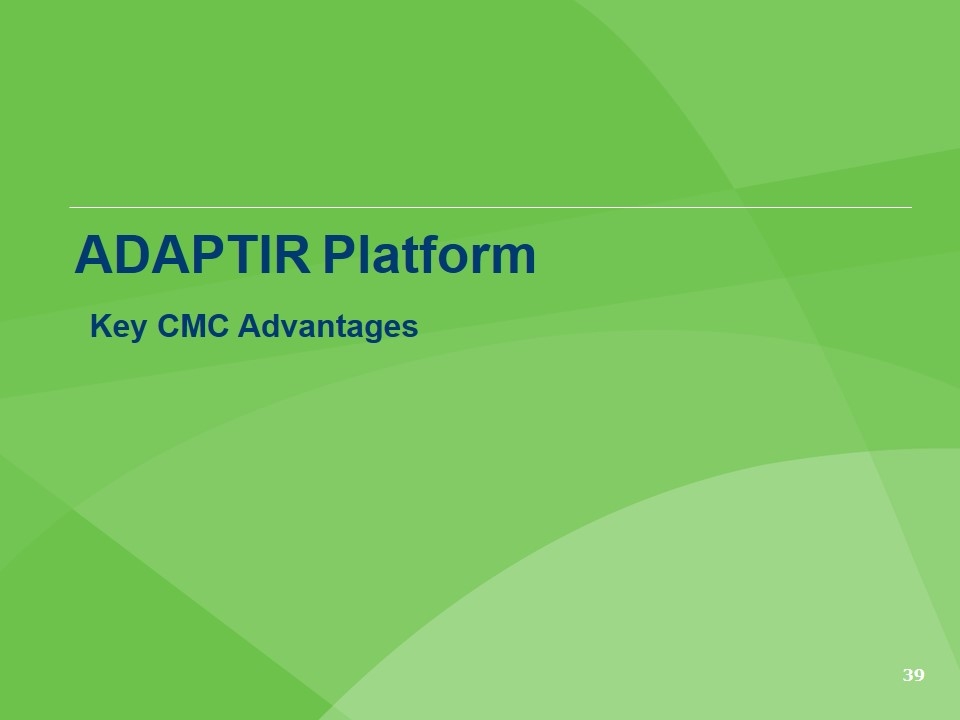
ADAPTIR Platform Key CMC Advantages
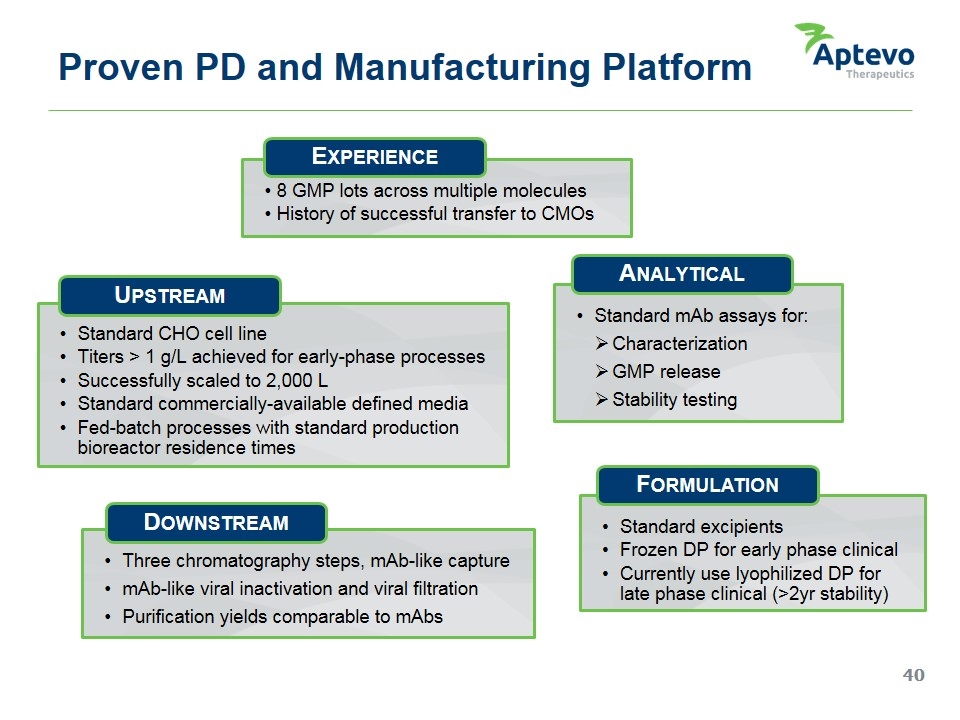
Proven PD and Manufacturing Platform 8 GMP lots across multiple molecules History of successful transfer to CMOs Experience Standard CHO cell line Titers > 1 g/L achieved for early-phase processes Successfully scaled to 2,000 L Standard commercially-available defined media Fed-batch processes with standard production bioreactor residence times Upstream Three chromatography steps, mAb-like capture mAb-like viral inactivation and viral filtration Purification yields comparable to mAbs Downstream Standard mAb assays for: Characterization GMP release Stability testing Analytical Standard excipients Frozen DP for early phase clinical Currently use lyophilized DP for late phase clinical (>2yr stability) Formulation
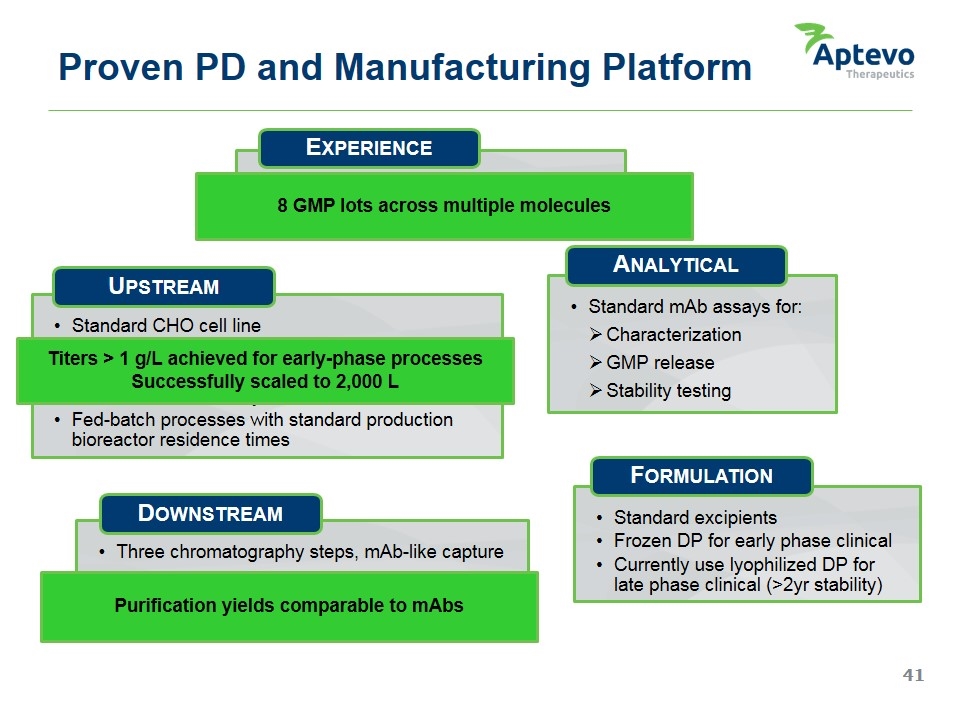
Proven PD and Manufacturing Platform 8 GMP lots across multiple molecules History of successful transfer to CMOs Experience Standard CHO cell line Titers > 1 g/L achieved for early-phase processes Successfully scaled to 2,000 L Standard commercially-available defined media Fed-batch processes with standard production bioreactor residence times Upstream Three chromatography steps, mAb-like capture mAb-like viral inactivation and viral filtration Purification yields comparable to mAbs Downstream Standard mAb assays for: Characterization GMP release Stability testing Analytical Standard excipients Frozen DP for early phase clinical Currently use lyophilized DP for late phase clinical (>2yr stability) Formulation Titers > 1 g/L achieved for early-phase processes Successfully scaled to 2,000 L Purification yields comparable to mAbs 8 GMP lots across multiple molecules
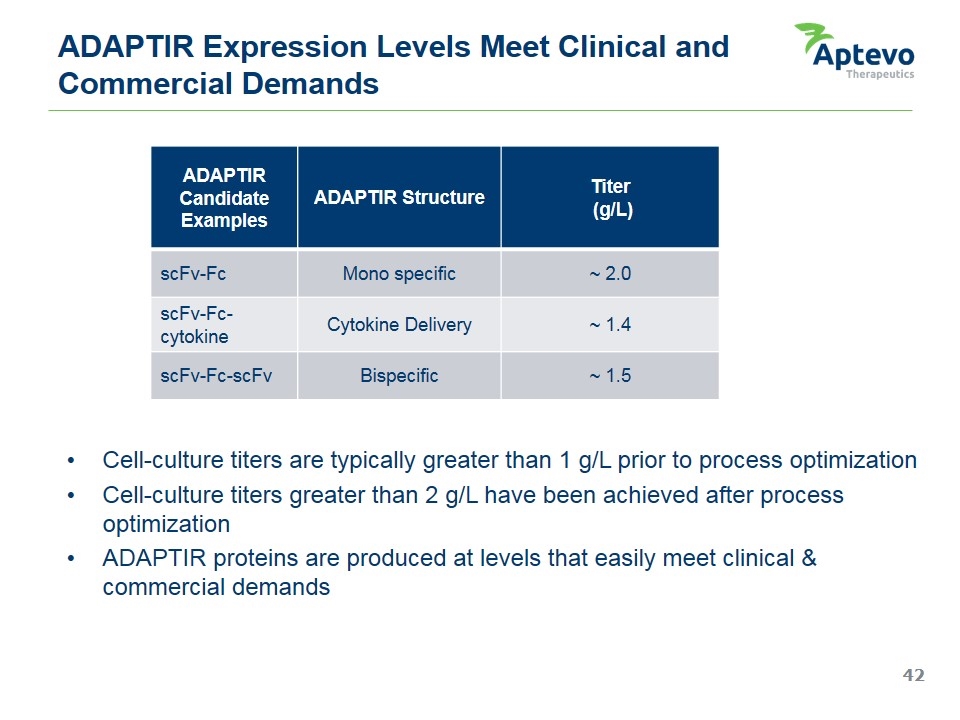
ADAPTIR Expression Levels Meet Clinical and Commercial Demands Cell-culture titers are typically greater than 1 g/L prior to process optimization Cell-culture titers greater than 2 g/L have been achieved after process optimization ADAPTIR proteins are produced at levels that easily meet clinical & commercial demands ADAPTIR Candidate Examples ADAPTIR Structure Titer (g/L) scFv-Fc Mono specific ~ 2.0 scFv-Fc-cytokine Cytokine Delivery ~ 1.4 scFv-Fc-scFv Bispecific ~ 1.5
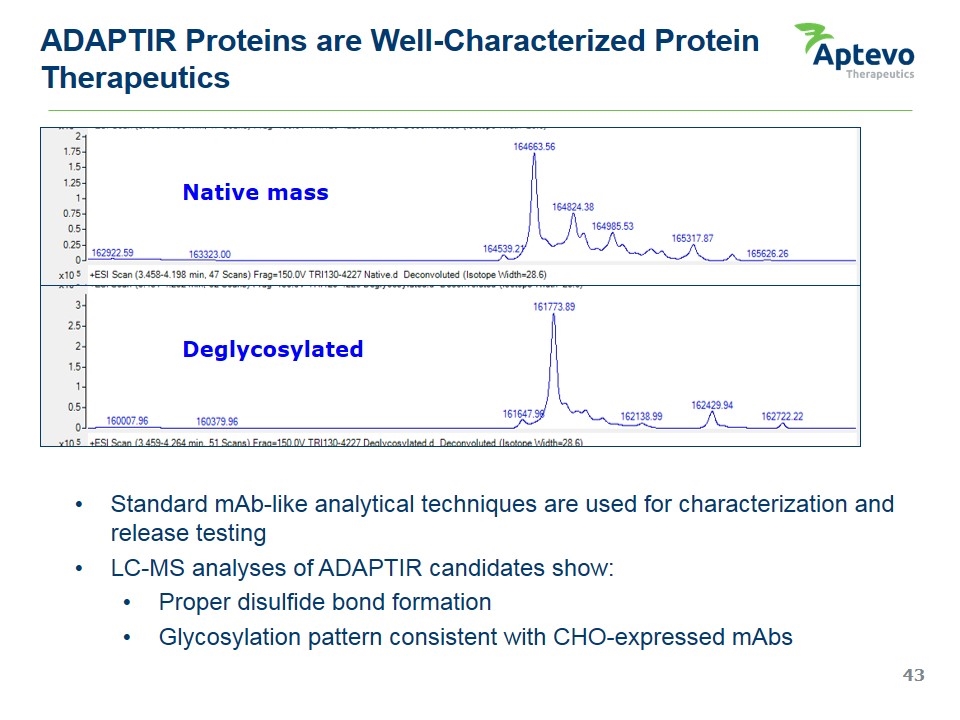
Deglycosylated ADAPTIR Proteins are Well-Characterized Protein Therapeutics Standard mAb-like analytical techniques are used for characterization and release testing LC-MS analyses of ADAPTIR candidates show: Proper disulfide bond formation Glycosylation pattern consistent with CHO-expressed mAbs Native mass 3 2.5 2 1.75 1.5 1.25 1 0.75 0.5 0.25 0 x105 +ESI Scan (3.458-4.198 min, 47 Scans) Frag=150.0V TRI130-4227 Native.d Deconvoluted (Isotope Width=28.6) 162922.59 163323.00 164539.21 164663.56 164824.38 164985.53 165317.87 165626.26 160007.96 160379.96 161647.96 161773.89 162138.99 16249.94 162722.22 3.459-4.264 51
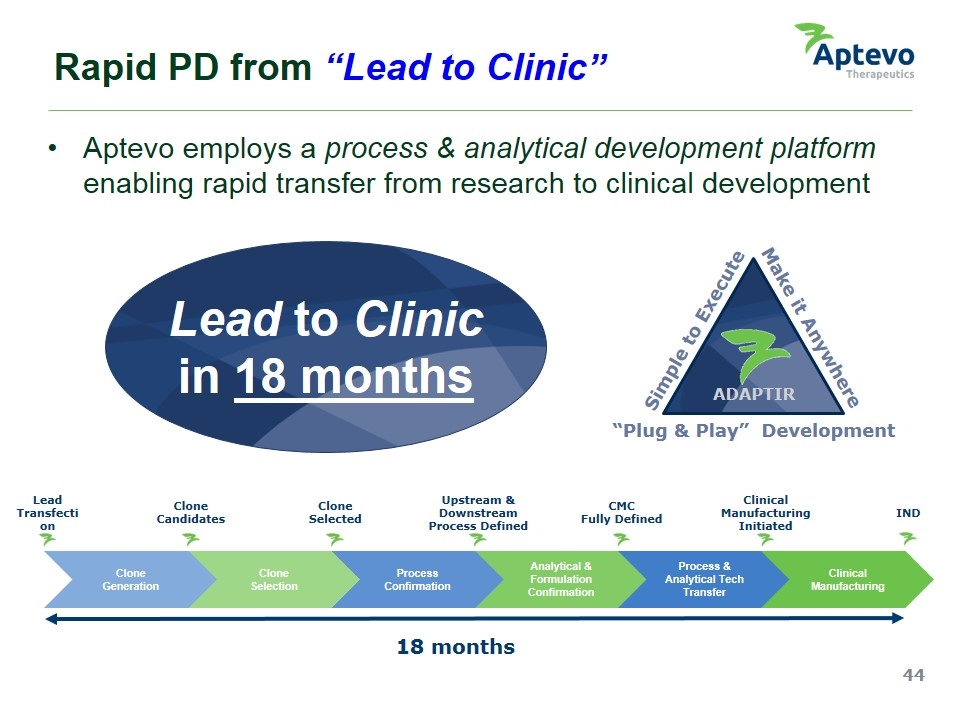
Aptevo employs a process & analytical development platform enabling rapid transfer from research to clinical development Rapid PD from “Lead to Clinic” Clone Selected Upstream & Downstream Process Defined CMC Fully Defined Clinical Manufacturing Initiated 18 months Clone Candidates Lead to Clinic in 18 months “Plug & Play” Development Simple to Execute Make it Anywhere ADAPTIR IND Analytical & Formulation Confirmation Process Confirmation Process & Analytical Tech Transfer Clinical Manufacturing Clone Selection Clone Generation Lead Transfection
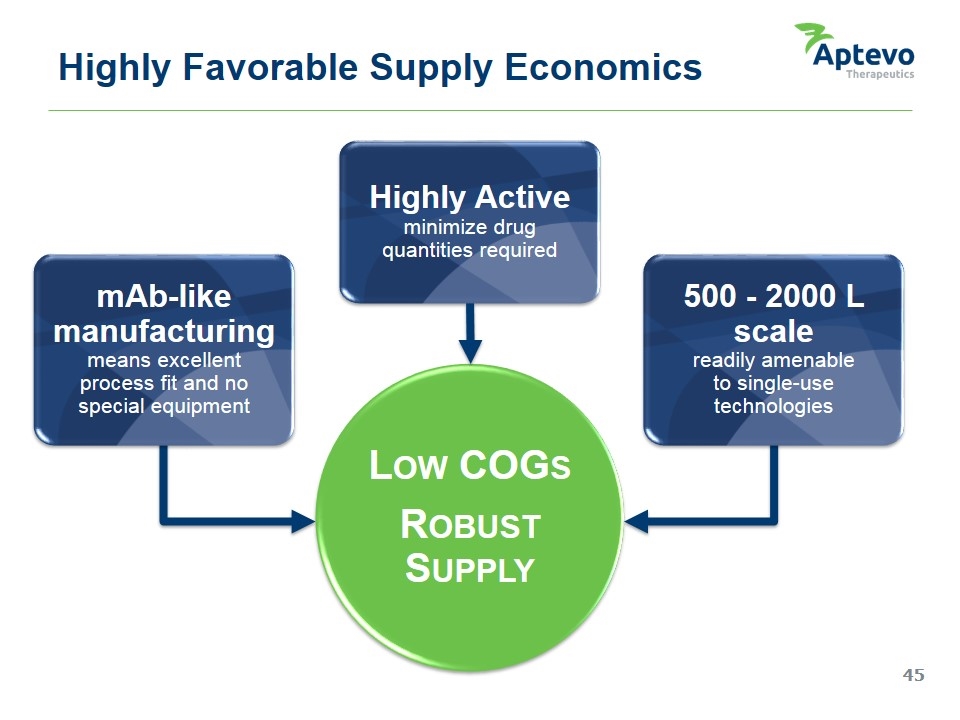
Highly Favorable Supply Economics Highly Active minimize drug quantities required Low COGs Robust Supply mAb-like manufacturing means excellent process fit and no special equipment 500 - 2000 L scale readily amenable to single-use technologies *In preclinical experiments
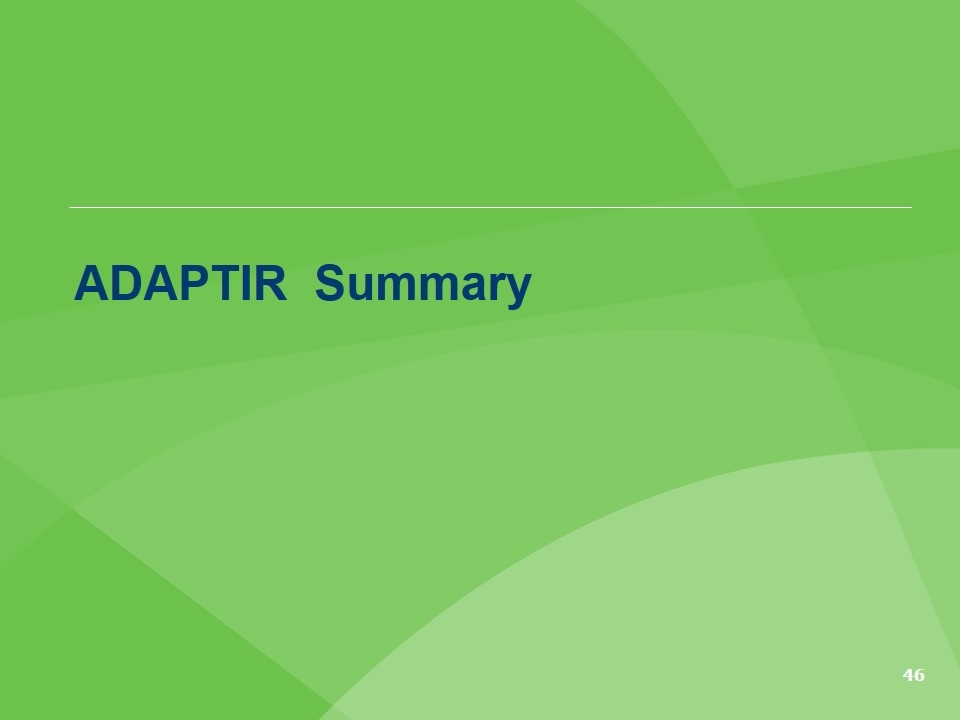
ADAPTIR Summary
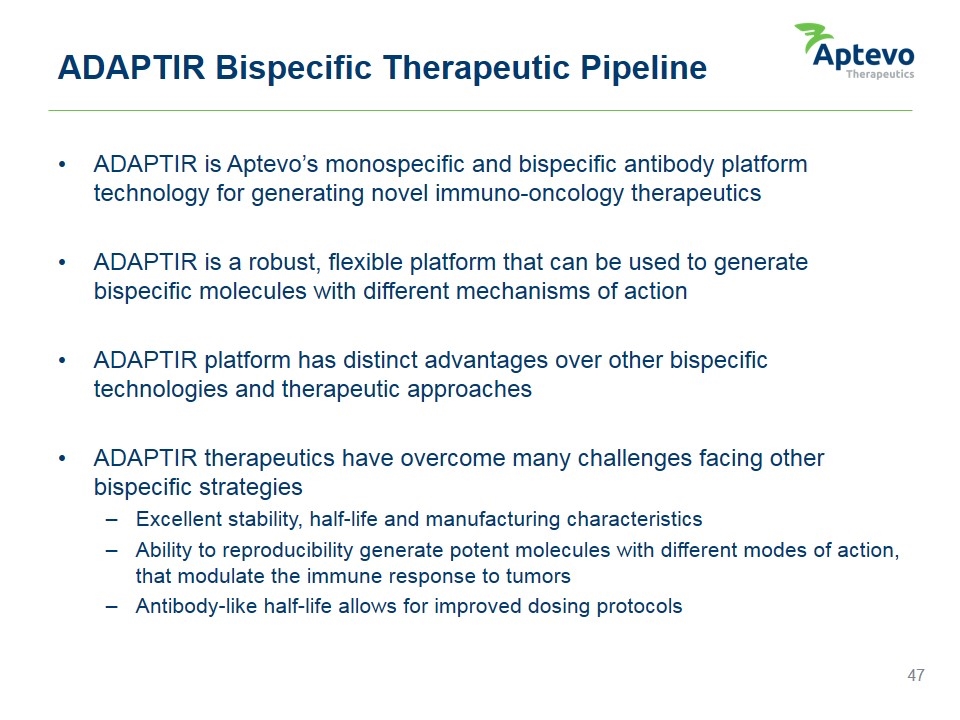
ADAPTIR is Aptevo’s monospecific and bispecific antibody platform technology for generating novel immuno-oncology therapeutics ADAPTIR is a robust, flexible platform that can be used to generate bispecific molecules with different mechanisms of action ADAPTIR platform has distinct advantages over other bispecific technologies and therapeutic approaches ADAPTIR therapeutics have overcome many challenges facing other bispecific strategies Excellent stability, half-life and manufacturing characteristics Ability to reproducibility generate potent molecules with different modes of action, that modulate the immune response to tumors Antibody-like half-life allows for improved dosing protocols ADAPTIR Bispecific Therapeutic Pipeline

Back-up
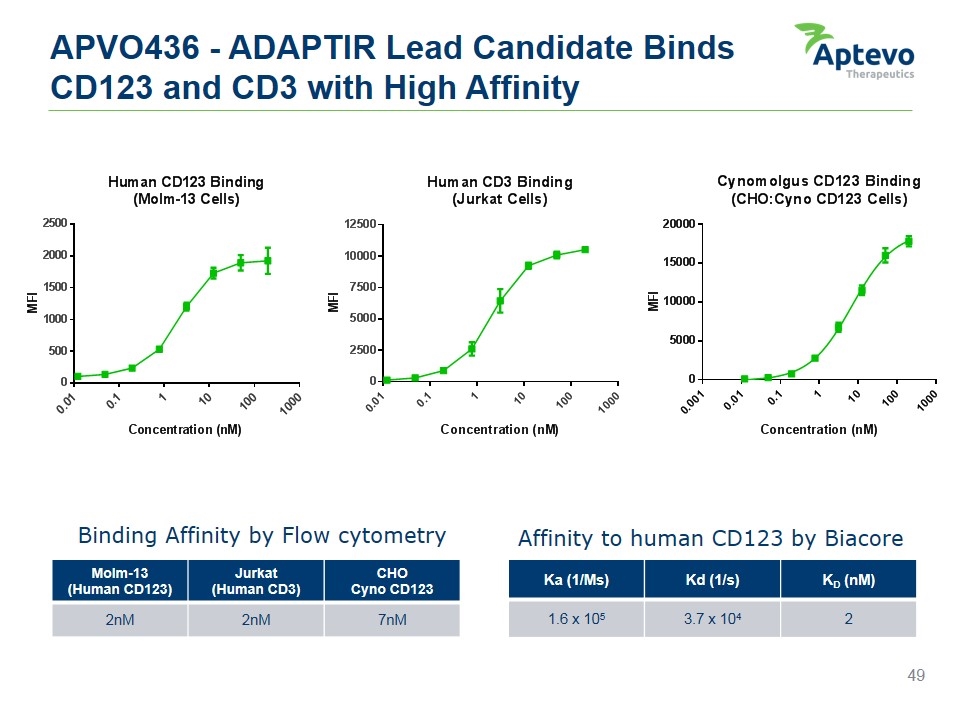
APVO436 - ADAPTIR Lead Candidate Binds CD123 and CD3 with High Affinity Molm-13 (Human CD123) Jurkat (Human CD3) CHO Cyno CD123 2nM 2nM 7nM Ka (1/Ms) Kd (1/s) KD (nM) 1.6 x 105 3.7 x 104 2 Binding Affinity by Flow cytometry Binding Affinity to Human CD123 by SPR Affinity to human CD123 by Biacore Human CD123 Binding (Molm-13 Cells) 2500 2000 1500 1000 500 0 0.01 0.1 1 10 100 1000 MFI Concentration (nM) Human CD3 Binding (Jurkat Cells) Cynomolgus CD123 Binding (CHO:Cyno CD123 Cells) 0.001
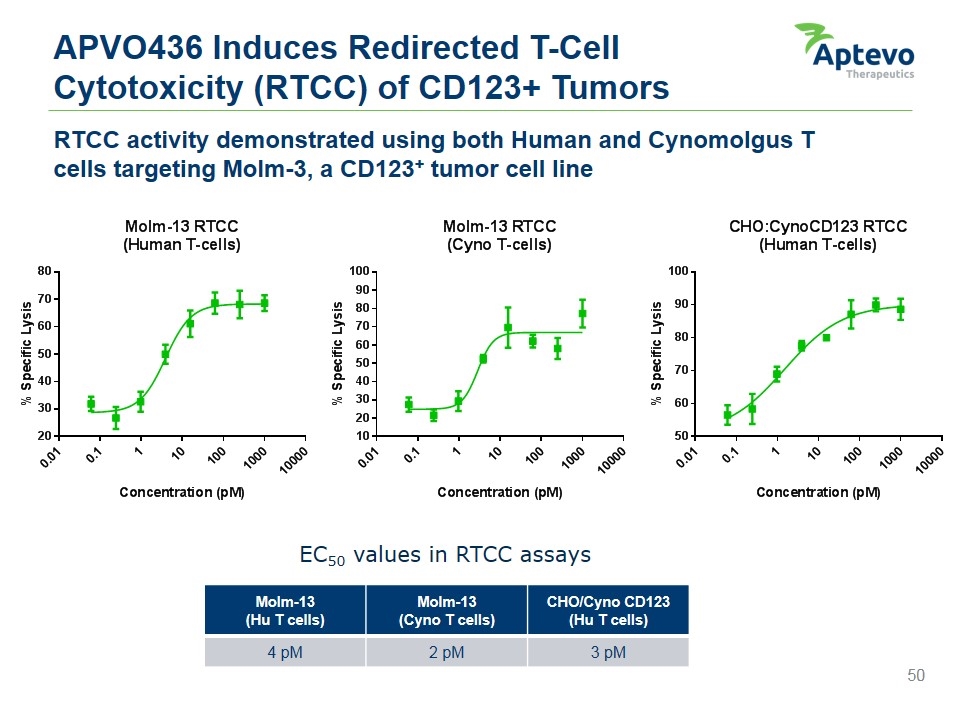
APVO436 Induces Redirected T-Cell Cytotoxicity (RTCC) of CD123+ Tumors RTCC activity demonstrated using both Human and Cynomolgus T cells targeting Molm-3, a CD123+ tumor cell line Molm-13 (Hu T cells) Molm-13 (Cyno T cells) CHO/Cyno CD123 (Hu T cells) 4 pM 2 pM 3 pM EC50 values in RTCC assays Molm-13 RTCC (Human T-cells) 80 70 60 50 40 30 20 0.01 0.1 10 100 1000 10000 % Specific Lysis Molm-13 RTCC (Cyno T-cells) CHO:CynoCD123 RTCC (Human T-cells) Concentration (pM) 90

APVO436 Induces Target Dependent T-cell Activation CD4+ T cells CD8+ T cells 1 pM 2 pM EC50 values in activation assays APVO436 Induces T cell Activation of CD4 and CD8 T cells and Induces Proliferation of Both T-cell subsets (data not shown) CD4+:CD69% 100 80 60 40 20 0 0.01 0.1 1 10 100 1000 10000 Molm-13 C4-2B CD8+ T-cell Activation Concentration (pM)
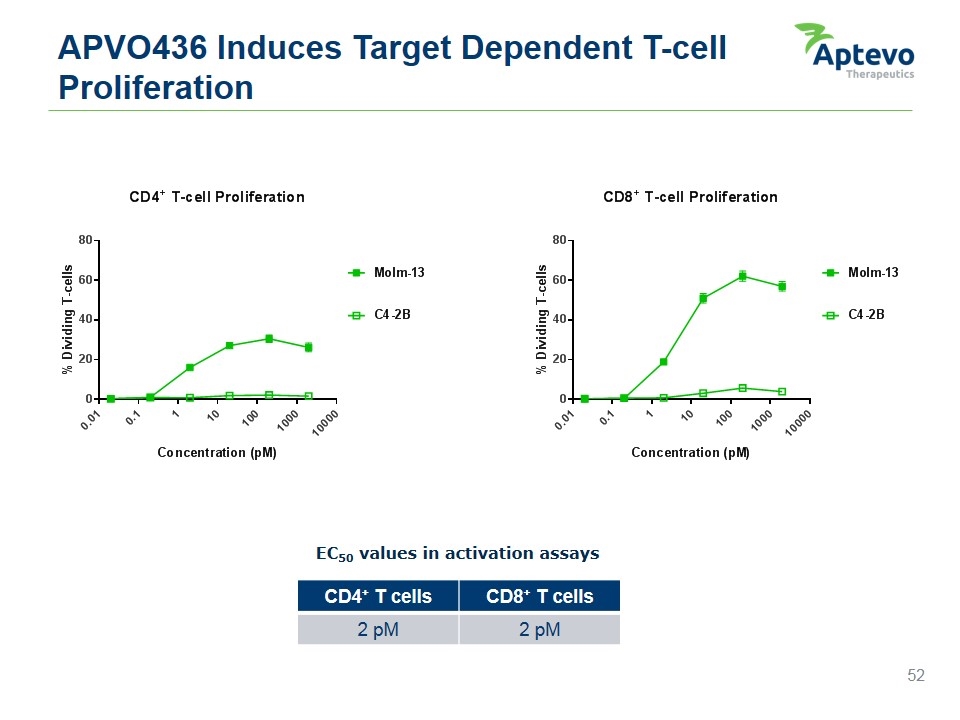
APVO436 Induces Target Dependent T-cell Proliferation EC50 values in activation assays CD4+ T cells CD8+ T cells 2 pM 2 pM CD4+ T-cell Proliferation % Dividing T-cells 80 60 40 20 0 0.01 0.1 1 10 100 1000 10000 CD8+ T-cell Proliferation Molm-13 C4-2B Concentration (pM)
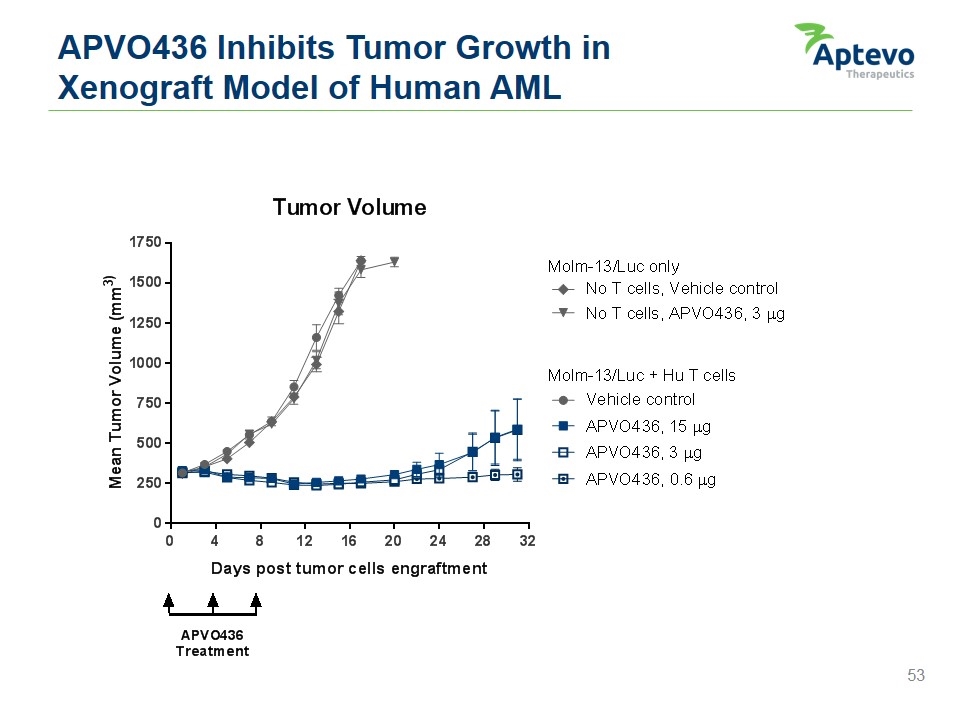
APVO436 Inhibits Tumor Growth in Xenograft Model of Human AML Tumor Volume Mean Tumor Volume (mm3) 1750 1500 1250 1000 750 500 250 0 0 4 8 12 16 20 24 28 32 Days post tumor cells engraftment APVO436 Treatment Molm-13/Luc only No T cells, Vehicle control No T cells, APVO436, 3 μg Molm-13/Luc + Hu T cells Vehicle control APV0436, 15 μg AVPO436, 3 μg APVO436, 0.6 μg




















































